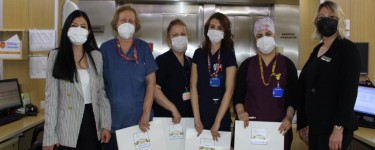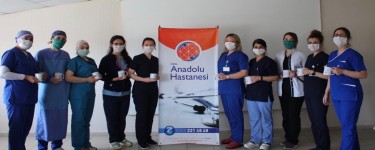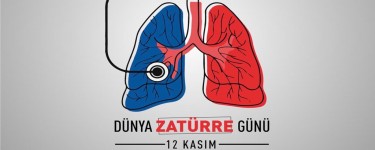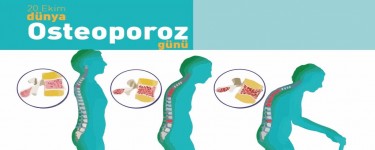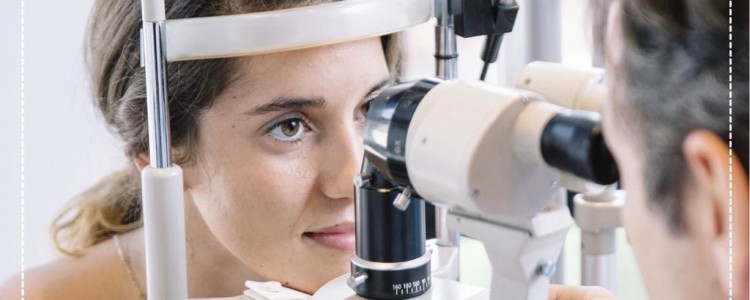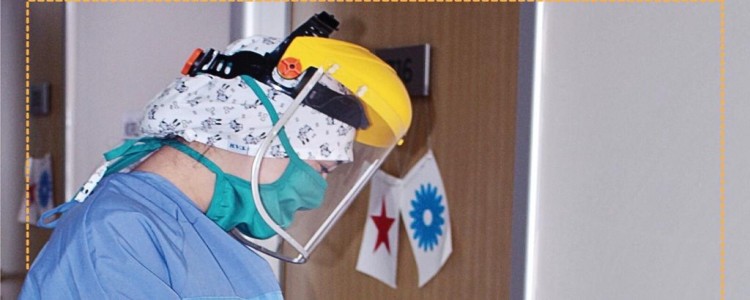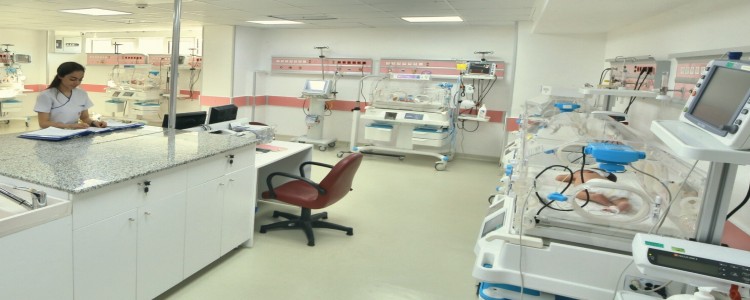News
2021
2019

26 12 2019
Hastanemiz Hemşirelik Hizmetleri Direktörü Gamze ONAR BAŞARANGİL, Etkin Koleji öğrenci ve öğretmenlerine “El Hijyeni” konulu seminer verdi.

11 01 2019
Kardiyoloji Doktorumuz Özcan Yücel Hastasını Ameliyat Gerekmeden Stent Takarak Tedavi Etti
Sağlıklı yarınlar için yeşil bir adım attık!

11 09 2025
Sağlıklı yarınlar için yeşil bir adım attık!
Ülkemizde son dönemde yaşanan orman yangınları hepimizin yüreğini derinden yaraladı.
Özel Anadolu Hastanesi olarak, Tema Vakfı iş birliğiyle 330 fidanı toprakla buluşturarak doğaya nefes, geleceğe umut olmak istedik.
Biz biliyoruz ki; sağlık, sadece bedenle değil, doğayla da mümkündür.
Her fidan, kaybettiğimiz ormanların ve geleceğimizin yeniden yeşermesi için bir umuttur.
Sosyal sorumluluk projeleri kapsamında Eskişehir Sanayi Odası Genel Sekreter Yardımcısı Sayın Hakkı SARPKAYA ile görüşme gerçekleştirdik.

07 08 2025
Sosyal sorumluluk projeleri kapsamında Eskişehir Sanayi Odası Genel Sekreter Yardımcısı Sayın Hakkı SARPKAYA ile görüşme gerçekleştirdik.
Sosyal sorumluluk projeleri kapsamında Eskişehir Sanayi
Odası Genel Sekreter Yardımcısı Sayın Hakkı SARPKAYA ile görüşme
gerçekleştirdik.
Odunpazarı Belediye Başkanı Sayın Kazım KURT’u makamında ziyaret ettik.

29 07 2025
Odunpazarı Belediye Başkanı Sayın Kazım KURT’u makamında ziyaret ettik.
Hastane İşletme Direktörümüz Sayın Derya DEMİR ve Kurumsal İletişim ve Pazarlama Uzmanımız Sayın Sevim BAŞBUĞ ile birlikte Odunpazarı Belediye Başkanı Sayın Kazım KURT’u makamında ziyaret ettik. Ziyaretimizde, hastanemiz bünyesine katılan yeni hekimlerimiz ve sağlık hizmetlerimizi geliştirmeye yönelik güncel çalışmalarımız hakkında bilgi paylaşımında bulunduk. Sayın Başkanımız Kazım KURT’a nazik ev sahipliği ve misafirperverliği için teşekkür ederiz.
Anne ve Bebek İçin Doğal Bir Başlangıç: Normal Doğum

07 07 2025
Anne ve Bebek İçin Doğal Bir Başlangıç: Normal Doğum
Özel Eskişehir Anadolu Hastanesi olarak, anne adaylarını sağlıklı doğum konusunda bilinçlendirmeye devam ediyoruz. Normal doğum, annenin doğum sonrası süreci daha hızlı ve konforlu geçirmesini sağlarken, bebeklerin hayata daha sağlıklı bir başlangıç yapmasına imkân tanır.
Doğal ve güvenli bir doğum süreci için kadın hastalıkları ve doğum uzmanlarımızla her zaman yanınızdayız.
Women's Health Awareness Events

20 06 2025
Women's Health Awareness Events
Information activities carried out to raise women's awareness on health-related issues and to increase social awareness continue.
In this context, important information was shared on the protection of women's health, the importance of regular check-ups and the vital role of early diagnosis in the training given by Gynecology and Obstetrics Specialist Dr. Burak Kenar.
These trainings, which aim to raise awareness on women's rights and needs regarding health, are receiving great interest from the participants.
We are getting stronger with awareness and moving forward with health.
TS ISO 10002 kalite belgemiz onaylandı
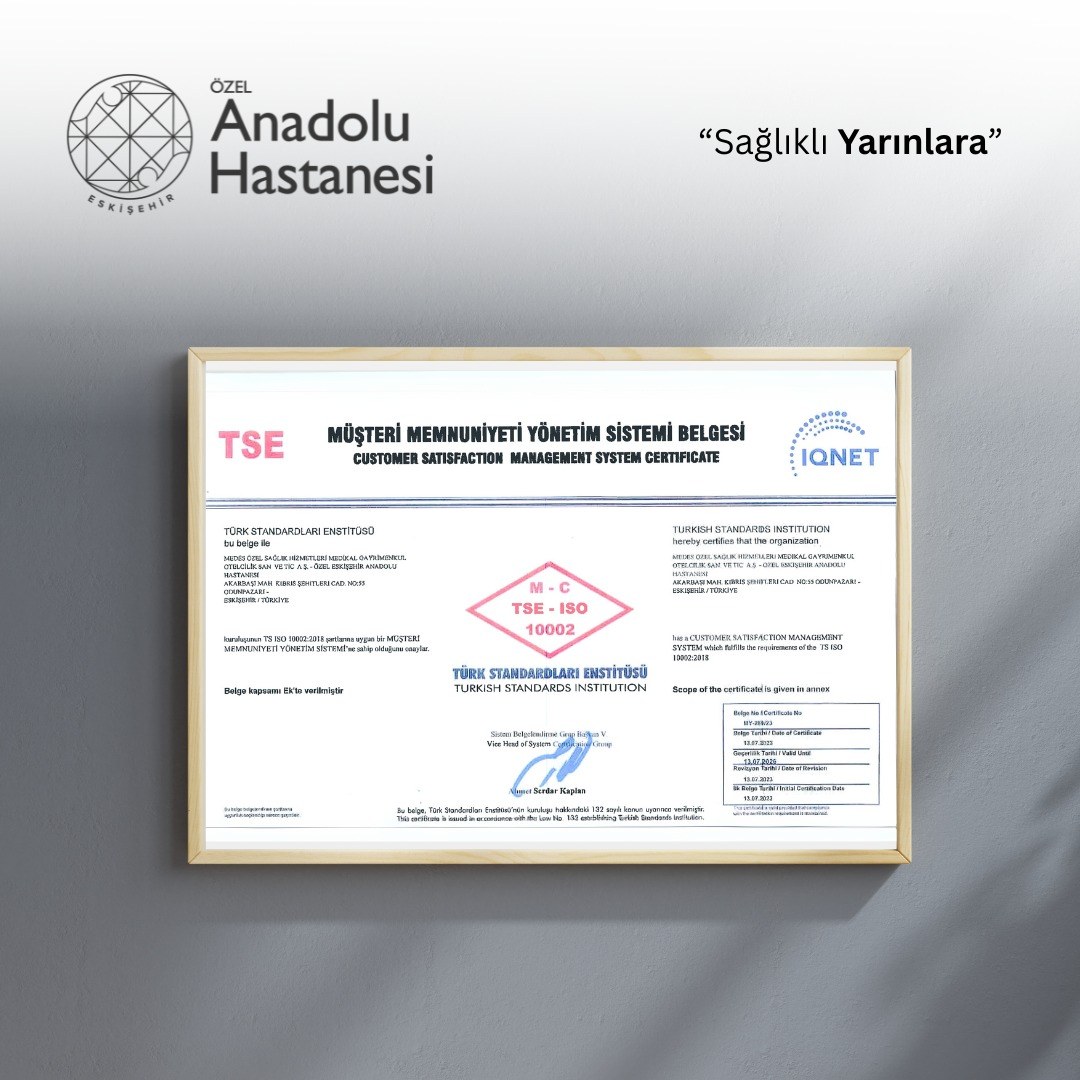
13 06 2025
TS ISO 10002 kalite belgemiz onaylandı
We are pleased to announce that Özel Eskişehir Anadolu Hastanesi has successfully completed the audit process, which we conduct with the understanding of continuously improving our service quality.
As a result of the evaluation carried out by the Turkish Standards Institute (TSE), our institution's compliance with regulations, transparency, and sustainable management approach have been reaffirmed.
We extend our gratitude to all our teammates and stakeholders who contributed to this process, and we respectfully declare that we will continue our work with the same quality and determination.
Sağlık ve Spor El Ele!

06 05 2025
Sağlık ve Spor El Ele!
Sağlık ve Spor El Ele!
Hastane olarak 7’den 70’e sağlıklı yaşamı teşvik etmeye devam ediyoruz. Bu kapsamda, spor salonu ile yapılan anlaşma doğrultusunda cross-fit etkinliğine yönelik iş birliği sağladık.
Spor salonu yetkilisi Sn. Hakan YAĞCI ve Hastanemiz İşletme Direktörü Sn. Derya DEMİR arasında imzalanan bu iş birliği ile, 9-11 Mayıs tarihleri arasında düzenlenecek cross-fit etkinliğine destek olmaktan mutluluk duyuyoruz.
Hep birlikte daha sağlıklı yarınlara!
Kırmızı Kod Tatbikatı Ve Yangın Eğitimi
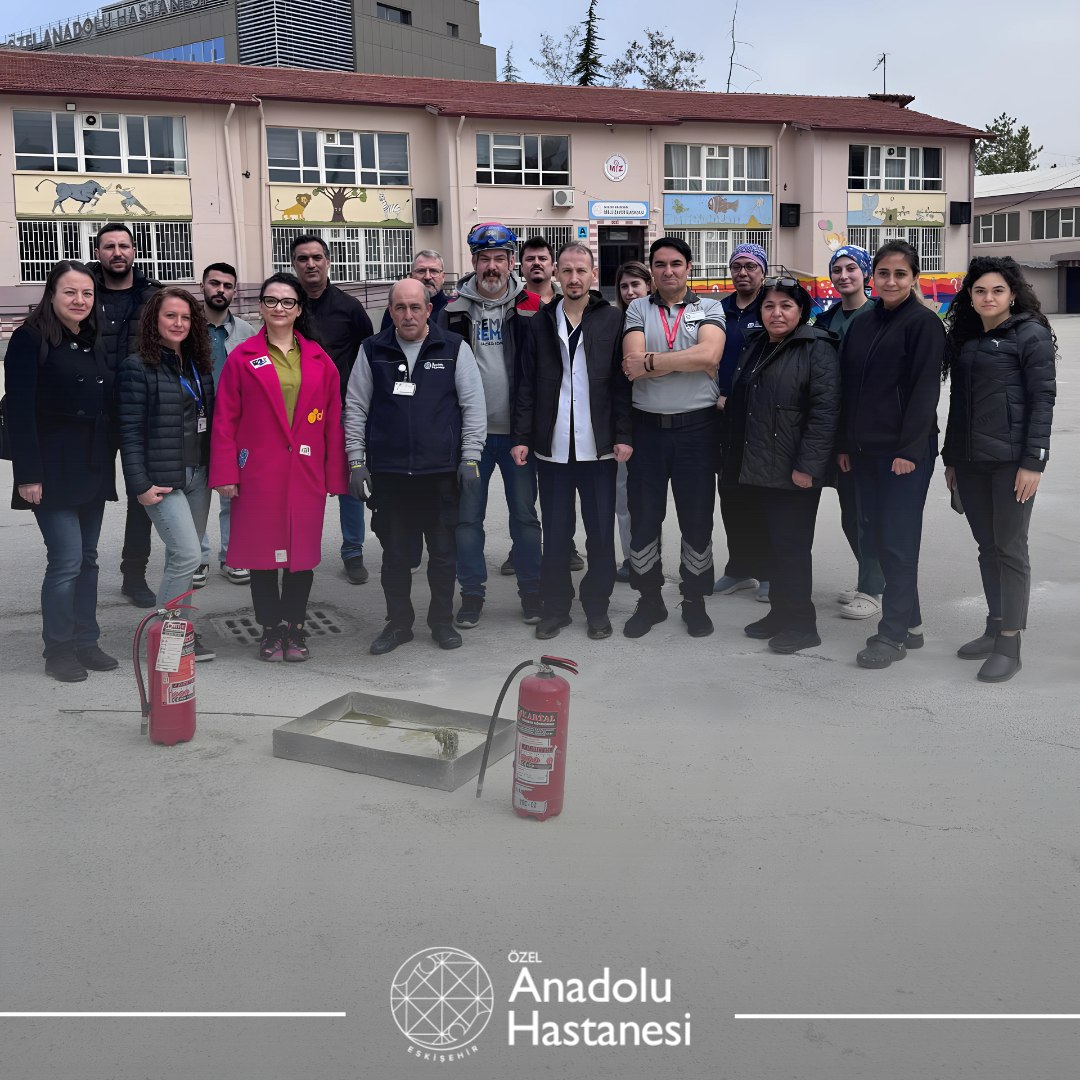
07 04 2025
Kırmızı Kod Tatbikatı Ve Yangın Eğitimi
Özel Eskişehir Anadolu Hastanesi, Yangın Eğitmeni Cüneyt Yılmaz tarafından verilen kapsamlı yangın eğitimi çerçevesinde, yasal zorunluluklar doğrultusunda Kırmızı Kod Tatbikatı'nı başarıyla gerçekleştirdi.
Eğitimin teorik bölümünün ardından uygulamaya geçilen tatbikatta, hastanenin acil durum ekipleri aktif rol aldı. Senaryo gereği çıkan yangına müdahale ve hasta tahliyesi gibi kritik adımlar, ekipler tarafından titizlikle uygulandı.
Tatbikatın uygulama bölümü, Milli Zafer İlköğretim Okulu bahçesinde gerçekleştirildi. Gerçeği aratmayan senaryo ve ekiplerin koordineli çalışması, tatbikatın başarıyla tamamlanmasını sağladı.
Özel Eskişehir Anadolu Hastanesi yetkilileri, yapılan bu tür eğitim ve tatbikatların, olası bir yangın durumunda can ve mal kaybını en aza indirmek adına büyük önem taşıdığını vurguladı. Ayrıca, acil durum ekiplerinin bilgi ve becerilerini güncel tutmanın ve kurumlar arası işbirliğinin önemine dikkat çekildi.
Yangın Eğitmeni Cüneyt Yılmaz ise, tatbikata katılan hastane personeline gösterdikleri özveri ve başarılı uygulamalarından dolayı teşekkür etti.
Kadın Sağlığı İçin Bilgilendirme Etkinliği Düzenlendi
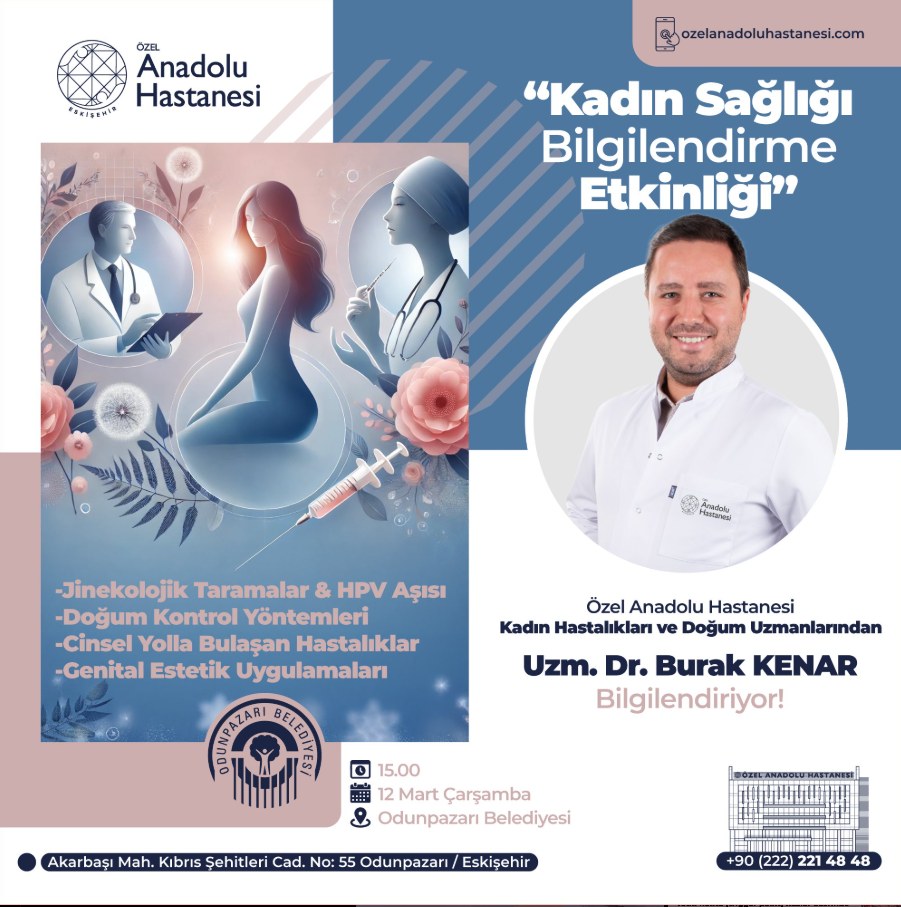
12 03 2025
Kadın Sağlığı İçin Bilgilendirme Etkinliği Düzenlendi
Özel Anadolu Hastanesi Kadın Hastalıkları ve Doğum Uzmanı Uzm. Dr. Burak Kenar, Odunpazarı Belediyesi iş birliğiyle düzenlenen etkinlikte kadın sağlığına dair önemli konuları ele aldı. 12 Mart’ta gerçekleşen etkinlikte jinekolojik taramalar, HPV aşısı, doğum kontrol yöntemleri, cinsel yolla bulaşan hastalıklar ve genital estetik uygulamaları hakkında bilgilendirme yapıldı.
What ıs Obesıty?

04 03 2025
What ıs Obesıty?
The definition of obesity varies depending on what one reads. In general, overweight and obesity indicate a weight greater than what is healthy. Obesity is a chronic condition defined by an excess amount of body fat. A certain amount of body fat is necessary for storing energy, heat insulation, shock absorption, and other functions.Obesity is not just a cosmetic consideration; it is harmful to one's health as it is a risk factor for many conditions.
Sağlık Hizmetlerinde İşbirliği: Dernek ve Sendikalarla Protokol İmzaladı

15 02 2025
Sağlık Hizmetlerinde İşbirliği: Dernek ve Sendikalarla Protokol İmzaladı
Eskişehir Erzurumlular Sosyal Yardımlaşma Kültür ve Dayanışma Derneği ve Eskişehir Yeni Sendika (Yenilikçi Sağlık ve Sosyal Hizmet Çalışanları Sendikası) arasında hastanemiz ile anlaşma protokolü imzaladık.
Hastane İşletme Direktörümüz Derya Demir, Odunpazarı Belediye Başkan Yardımcısı Sayın Necati Sarıca'yı makamında ziyaret etti.

07 02 2025
Hastane İşletme Direktörümüz Derya Demir, Odunpazarı Belediye Başkan Yardımcısı Sayın Necati Sarıca'yı makamında ziyaret etti.
Hastane İşletme Direktörümüz Derya Demir, Odunpazarı Belediye Başkan Yardımcısı Sayın Necati Sarıca’yı makamında ziyaret etti. Ziyaret kapsamında, hastanemiz ve belediye arasında iş birliğini güçlendirecek bir protokol imzalandı. Nazik misafirperverliği ve yakın ilgisi için Sayın Necati Sarıca’ya teşekkür ederiz.
Hastanemizden Çalışanlarına Anlamlı Hediye

01 02 2025
Hastanemizden Çalışanlarına Anlamlı Hediye
Hastanemizde düzenlenen hizmet içi eğitimlere katılarak kendilerini sürekli geliştiren değerli çalışma arkadaşlarımıza teşekkür ediyoruz. Daha bilinçli ve donanımlı bir sağlık hizmeti sunma yolunda öğrenmeye olan bağlılıklarını takdir ettiğimiz sevgili çalışanlarımıza, bu anlamlı çabalarını taçlandırmak adına keyifle okuyacakları birer kitap hediye ettik.
Hastanemiz, çalışanlarının gelişimine büyük önem veriyor ve bu tür etkinliklerle onların bilgi ve becerilerini artırmayı hedefliyor. Hizmet içi eğitimlere katılım gösteren tüm çalışanlarımızı tebrik ediyor, başarılarının devamını diliyoruz.
Cervıcal Cancer Awareness Month

06 01 2025
Cervıcal Cancer Awareness Month
Although cervical cancer is usually seen in middle and older women, it can occur at any age. It is very important for women to have regular smear tests for early diagnosis. It is a disease that can be treated if diagnosed early. Human Papilloma Virus Infection test and Pap Smear test which can cause cervical cancer are performed as free in KETEM in our country.
"Sağlıklı İletişim" eğitimi

29 12 2024
"Sağlıklı İletişim" eğitimi
Çalışanlarımızın kişisel ve profesyonel gelişimlerine büyük önem veriyoruz. Bu kapsamda, 4 gün boyunca Eskişehir Öğretmenevi Eğitim Salonu'nda düzenlediğimiz "Sağlıklı İletişim" eğitimi başarıyla tamamlanmıştır.
Eğitimimiz, alanında uzman Prof. Dr. Erkan Yüksel tarafından verildi. Katılımcılarımıza, etkili iletişim becerileri, empati kurma, aktif dinleme ve daha birçok konuda önemli bilgiler aktarıldı. Amacımız, çalışanlarımızın birbirleriyle ve müşterilerimizle daha sağlıklı ve verimli iletişim kurabilmelerini sağlamaktı.
Tüm birimlerimizden yoğun katılımla gerçekleşen eğitimimizde, çalışanlarımızın etkin bir şekilde yer alması ve eğitimden maksimum fayda sağlaması için özel bir katılım planlaması yapılmıştı. Bu sayede, tüm çalışanlarımızın eğitime eşit fırsat bulması hedeflendi.
Bölüm yöneticilerimizin de bu süreçte gösterdikleri destek ve yönlendirme sayesinde eğitimimiz büyük bir başarıyla sonuçlanmıştır.
Cumhuriyet Başsavcısı Karakülah'ı Ziyaret Ettik

19 12 2024
Cumhuriyet Başsavcısı Karakülah'ı Ziyaret Ettik
Hastane İşletme Direktörümüz Derya Demir ve Kurumsal İletişim ve Pazarlama Uzmanımız Sevim Başbuğ ile birlikte, Hakimler ve Savcılar Kurulu Kararnamesi ile Eskişehir Cumhuriyet Başsavcılığına atanan Sayın Üzeyir Karakülah’ı makamında ziyaret ettik. Bu ziyaret sırasında, hastanemiz ve kurum arasında bir protokol imzaladık.
Sayın Üzeyir Karakülah’a nazik misafirperverliği ve gösterdiği yakın ilgi için teşekkür eder, yeni görevinde başarılar dileriz.
Anne ve Bebek Sağlığına Özel Seminer

16 12 2024
Anne ve Bebek Sağlığına Özel Seminer
Anne ve bebek sağlığı konusunda uzman kadrosuyla özel bir seminer düzenledi. Seminerde, alanında uzman doktorlar, ebeler, hemşireler, diyetisyen, fizyoterapist ve psikolog katılımcılara kapsamlı bilgiler sundu.
Gerçekleşen seminerde, hamilelik süreci, doğum, emzirme, bebek bakımı, anne ve bebek sağlığına yönelik beslenme, doğum sonrası dönemde annelerin fiziksel ve duygusal sağlığı gibi konularda detaylı bilgiler verildi.
Özel Anadolu Hastanesi’nden Paşabahçe Fabrikası’nda Diyabet Teknolojileri Semineri

14 11 2024
Özel Anadolu Hastanesi’nden Paşabahçe Fabrikası’nda Diyabet Teknolojileri Semineri
Ülkemizin önde gelen üretim tesislerinden biri
olan Paşabahçe Fabrikası, çalışanlarının sağlığını desteklemeye yönelik önemli
bir etkinliğe ev sahipliği yaptı. Uzm. Dr. Osman Son,
fabrikanın çalışanlarına yönelik “Diyabet Teknolojileri” konulu bir seminer
gerçekleştirdi.
Seminerde, modern tıp teknolojilerinin diyabet
yönetimindeki rolü detaylı bir şekilde ele alındı. Uzm. Dr. Osman Son,
insülin pompaları, sürekli glikoz ölçüm cihazları ve diyabet yönetiminde
kullanılan mobil uygulamalar gibi yenilikçi çözümlerle diyabet hastalarının
yaşam kalitesinin nasıl artırılabileceğini anlattı. Çalışanlar, diyabetle
ilgili doğru bilgiye erişmenin yanı sıra, teknolojik yeniliklerden nasıl
faydalanabilecekleri konusunda da bilgilendirildi.
Ayrıca, seminer kapsamında diyabetin önlenmesi,
sağlıklı beslenme, düzenli egzersiz ve iş yaşamında kan şekeri dengesinin
korunmasına yönelik öneriler de sunuldu. Katılımcılar, konuya dair merak
ettiklerini sorma ve birebir bilgi alma fırsatı buldu.
Değerli katkılarından dolayı Uzm.
Dr. Osman Son’a teşekkürlerimizi sunarız.
Obezite Cerrahisi Uygulama Merkezimiz Hizmete Girdi!

13 11 2024
Obezite Cerrahisi Uygulama Merkezimiz Hizmete Girdi!
Sağlık Bakanlığı Sağlık Hizmetleri Genel Müdürlüğü’nün 03.10.2024 tarihli yazısı ile Obezite Cerrahisi Uygulama Merkezimiz hizmete açılmıştır. 5.720 metrekare kapalı alan üzerinde, 63 hasta yatağı, 20 yoğun bakım yatağı ile yenidoğan yoğun bakım ünitemiz, koroner yoğun bakım ünitemiz, kardiyovasküler yoğun bakım ünitemiz ve 23 farklı bölüm ile poliklinik hizmetlerimiz ile sağlık hizmetlerimiz de bölge halkına sağlık hizmeti sunmaktan gurur duyuyoruz. Şimdi ise, hastalarımıza sağlıklı bir yaşam sunmayı amaçlayan Obezite Cerrahisi Uygulama Merkezimizi hizmete açıyoruz.
Obezite Cerrahisi Uygulama Merkezimiz, alanında uzman cerrahlarımız ve sağlık ekibimizle obeziteyle mücadele eden hastalarımıza kapsamlı bir tedavi süreci sunmaktadır. Merkezimizde, cerrahi yöntemlerin yanı sıra, her hastaya özel kişiselleştirilmiş bir tedavi planı uygulanmaktadır. Obeziteyle mücadelede gerekli olan tüm desteği ve güvenilir tıbbi altyapıyı sağlayan merkezimizde, sağlıklı bir yaşama adım atmak isteyen herkesi aramızda görmekten mutluluk duyarız.
Europen Fabrikalarında Kas ve İskelet Sistemi Ağrıları Semineri

06 11 2024
Europen Fabrikalarında Kas ve İskelet Sistemi Ağrıları Semineri
Fizik Tedavi ve Rehabilitasyon Uzmanı Uzm.
Dr. Serap Yılmaz Demiriz, Europen Merkez Fabrika ve Europen İmişehir
Fabrikası çalışanlarıyla bir araya gelerek "Kas ve İskelet Sistemi
Ağrıları" konulu bir seminer verdi.
Çalışanların iş yaşamında sıkça karşılaştığı kas
ve iskelet sistemi rahatsızlıkları, üretkenliği ve yaşam kalitesini olumsuz
etkileyebiliyor. Bu nedenle, seminerde bu tür rahatsızlıkların nedenleri,
belirtileri ve önlenmesi konusunda detaylı bilgiler paylaşıldı. Ayrıca, doğru
duruş teknikleri, ergonomi kuralları ve günlük hayatta uygulanabilecek basit
egzersiz önerileri katılımcılarla paylaşılırken, pratik ve uygulanabilir
çözümler sunuldu.
Seminer boyunca katılımcılar, konuya dair merak
ettiklerini sorma fırsatı bulurken, Uzm. Dr. Serap Yılmaz Demiriz'in
verdiği değerli bilgilerle farkındalık kazandı. Çalışanların yoğun ilgisi ve
olumlu geri bildirimleri, bu tür etkinliklerin önemini bir kez daha ortaya
koydu.
Özel Anadolu Hastanesi olarak sağlığınızı ön
planda tutmaya devam edecek ve iş yaşamındaki sağlık sorunlarının önüne geçmek
adına bu tür farkındalık etkinliklerini sürdürmeyi hedefleyeceğiz.
Organ Bağışı Farkındalık Haftası'nda Hastanemizde Farkındalık Standı Açıldı

05 11 2024
Organ Bağışı Farkındalık Haftası'nda Hastanemizde Farkındalık Standı Açıldı
Hastanemizde, 3-8 Kasım Organ Bağışı Farkındalık Haftası kapsamında, organ bağışının önemi ve süreç hakkında toplumu bilinçlendirmek amacıyla bilgilendirme standı açılmıştır.
Hastanemizde açılan bu stantta, organ bağışı süreci hakkında merak edilen tüm sorulara yanıt veriliyor. Sağlık personelimiz, organ bağışının insan hayatını nasıl kurtardığını anlatıyor, bağış yapmanın yasal süreçleri hakkında detaylı bilgi sunuyor. Ayrıca, bağışta bulunmak isteyen vatandaşlarımıza yönlendirmeler yapılmakta ve süreç hakkında rehberlik edilmektedir.
Organ bağışının önemine dikkat çekmek ve daha fazla insanı bağış yapmaya teşvik etmek amacıyla düzenlediğimiz bu etkinlikte, ziyaretçilerimiz bilinçli bir bağışçı olmanın insani sorumluluğunu üstlenmenin yanı sıra, bağışın topluma sağladığı faydaları da öğrenme imkânına sahip oluyorlar.
Hasta Hakları Günü Kapsamında Bilgilendirme Standı Açıldı

26 10 2024
Hasta Hakları Günü Kapsamında Bilgilendirme Standı Açıldı
26 Ekim Hasta Hakları Günü dolayısıyla hastanemizde hasta hakları konusunda toplumsal farkındalığı artırmak amacıyla bir bilgilendirme standı açılmıştır.
Hastanemizde açılan bu bilgilendirme standında, hastalarımızın sahip olduğu haklar ve bu haklardan nasıl yararlanabilecekleri konusunda bilgilendirmeler yapılmaktadır. Sağlık hizmetlerimizin etkin bir şekilde kullanılması ve hastalarımızın haklarını en iyi şekilde öğrenmeleri amacıyla deneyimli sağlık personelimiz her türlü soruya yanıt veriyor ve ziyaretçilerimize rehberlik ediyor.
Bu etkinlikle amacımız, hasta haklarının sağlık sisteminin önemli bir parçası olduğunu vurgulamak ve hastalarımızı bilinçlendirerek haklarına sahip çıkmalarını sağlamaktır.
Eksozom Tedavisi ile Yenilikçi Sağlık Çözümleri Sunuyoruz

21 08 2024
Eksozom Tedavisi ile Yenilikçi Sağlık Çözümleri Sunuyoruz
Hastanemiz, sağlık alanında yenilikçi çözümleri şehrimizin önde gelen kurumlarının iş yeri hekimlerine tanıtmak amacıyla eksozom tedavisini tanıtan özel bir etkinlik düzenledi.
Eksozom tedavisi, son yıllarda hücresel düzeyde sağladığı yenilenme ve iyileşme potansiyeli ile dikkat çeken, ileri düzey bir tedavi yöntemidir. Hastanemizde gerçekleştirilen bu özel etkinlikte, iş yeri hekimlerine eksozom tedavisinin nasıl uygulandığı, hangi hastalıklarda etkili olduğu ve sağladığı faydalar hakkında detaylı bilgi sunuldu. Kardiyoloji uzmanlarımızdan Uzm. Dr. Murat TARAKTAŞ'ın sunumu ile eksozom tedavisinin insan vücudunda hasarlı hücreleri onarma ve dokuları yenileme kapasitesini ayrıntılı bir şekilde anlatarak, tedavi sürecini gözler önüne serdi.
Hedefimiz, iş yeri hekimlerimizin bu yenilikçi tedavi yöntemini daha yakından tanımasını sağlamak ve çalışan sağlığını iyileştirecek yöntemler hakkında bilgi sahibi olmalarına katkıda bulunmaktır.
17.Emirdağ Gurbetçi Festivali'nde yerimizi aldık.

03 08 2024
17.Emirdağ Gurbetçi Festivali'nde yerimizi aldık.
Emirdağ'ın coşkulu atmosferinde düzenlenen 17. Emirdağ Gurbetçi Festivali'nde, Eskişehir Anadolu Hastanesi'nin standı vatandaşların uğrak noktası oldu. Sağlık profesyonellerinin yer aldığı standda, katılımcılara çeşitli sağlık konularında bilgiler verildi, merak edilen sorular yanıtlandı.
Eskişehir Valisi Sayın Hüseyin AKSOY Hastanemize ziyaret gerçekleştirdi

30 07 2024
Eskişehir Valisi Sayın Hüseyin AKSOY Hastanemize ziyaret gerçekleştirdi
Eskişehir Valisi Sayın Hüseyin AKSOY Hastanemize ziyaret gerçekleştirdi. Başhekimimiz Uzm. Dr. Levent BİLİR ve Hastane İşletme Direktörümüz Derya DEMİR'in karşıladığı Sayın AKSOY'a gerçekleştirmiş oldukları ziyaretten dolayı teşekkür ederiz.
Yapay Zeka Destekli Ekokardiyografi Cihazı Tanıtım Etkinliği

20 07 2024
Yapay Zeka Destekli Ekokardiyografi Cihazı Tanıtım Etkinliği
Bu özel tanıtım etkinliğinde, yapay zeka destekli ekokardiyografi cihazımızın sunduğu yüksek hassasiyetli görüntüleme imkânları ve hızlı teşhis yetenekleri detaylı olarak paylaşıldı. Uzmanlarımız, cihazın nasıl çalıştığını, yapay zeka teknolojisinin tanı sürecinde sağladığı doğruluk oranlarını ve iş yeri hekimlerinin kalp sağlığı taramalarında cihazı nasıl kullanabileceklerini açıkladı.
Tanıtım etkinliğimizde, bu gelişmiş cihazın iş yeri hekimlerinin sağlık hizmetlerine katkıda bulunarak çalışan sağlığını nasıl iyileştirebileceği vurgulandı. Bu sayede, kalp hastalıklarının erken teşhisinin önemi ve yapay zeka destekli sağlık teknolojilerinin çalışma hayatına sağlayacağı avantajlar bir kez daha gözler önüne serildi.
Bilecik Belediye Başkanı Sayın Melek Mızrak Subaşı'nı makamında ziyaret ettik

13 07 2024
Bilecik Belediye Başkanı Sayın Melek Mızrak Subaşı'nı makamında ziyaret ettik
Bilecik Belediye Başkanı Sayın Melek Mızrak Subaşı'nı makamında ziyaret ettik. Hastane İşletme Direktörümüz Derya Demir ve Kurumsal İletişim ve Pazarlama Uzmanımız Nilay Aktaş'ın katılmış olduğu ziyarette, Sayın Subaşı'na yeni dönemde yürüteceği belediye başkanlığı görevinde başarı dileklerinde bulunduk. Göstermiş olduğu ilgi ve alakadan dolayı kendisine teşekkür ederiz.
Sivrihisar'da gerçekleştirilen Uluslararası Nasreddin Hoca Kültür ve Sanat Festivali'nde katılım sağladık.

07 07 2024
Sivrihisar'da gerçekleştirilen Uluslararası Nasreddin Hoca Kültür ve Sanat Festivali'nde katılım sağladık.
Sivrihisar'ın geleneksel hale gelen ve coşkulu atmosferiyle dikkat çeken Uluslararası Nasreddin Hoca Kültür ve Sanat Festivali'nde, Eskişehir Anadolu Hastanesi de sağlık hizmetiyle yer aldı. Festivale katılan vatandaşlar, hastanenin standını ziyaret ederek sağlık durumları hakkında bilgi alabilir, merak ettikleri sorulara yanıt bulabilirler.
Fenilketonuri Eğitimi

01 06 2024
Fenilketonuri Eğitimi
1 Haziran Ulusal Fenilketonüri günü dolayısı ile sağlık ve bakım hizmetlerimiz bünyesinde bulunan personelimize, fenilketonüri hakkında eğitim ve bilgilendirme faaliyetinde bulunduk. Sağlık ve Bakım Hizmetleri Müdür Yardımcımız Özge BENLİKAŞ’ın çeşitli sunumlar yaparak gerçekleştirmiş olduğu eğitim, personelimizin toplum sağlığı konusunda farkındalığının daha fazla artmasını sağlamıştır.
Eskişehir'de Dijital Sağlık Zirvesi

30 05 2024
Eskişehir'de Dijital Sağlık Zirvesi
Türkiye Bilişim Derneği tarafından düzenlenen 5. Eskişehir Sağlık ve Bilim Sempozyumu Eskişehir Osmangazi Üniversitesi Kongre Merkezi'nde düzenlendi. TBD Eskişehir Şubesi Yönetim Kurulu Başkanı Av. Dr. Barış GÜNAYDIN'ın konuşmaları ile başlayan sempozyumda, dijital sağlık ekosisteminde ki başarılı faaliyetlerde bulunan kurumlara ödül verildi. Dijital Hastane Kategorisinde ödüle layık görülen kurumumuz adına plaketimizi, TBD Genel Başkan Yardımcısı Ali YAZICI Başhekimimiz Uzm. Dr. Levent BİLİR'e takdim etti.
Odunpazarı Belediye Başkanı Sayın Kazım KURT ziyareti

28 05 2024
Odunpazarı Belediye Başkanı Sayın Kazım KURT ziyareti
Odunpazarı Belediye Başkanı Sayın Kazım KURT’u ziyaret ettik. Başhekimimiz Uzm. Dr. Levent BİLİR, Genel Müdürümüz Op. Dr. Cenk SOĞUKPINAR ve Kurumsal İletişim ve Pazarlama Uzmanımız Nilay AKTAŞ'ın katılımı ile gerçekleştirmiş olduğumuz ziyaretimiz esnasında, göstermiş olduğu ilgi ve alakadan dolayı kendisine bir kez daha teşekkür ederiz.
Eskişehir'de Sporcu Yaralanmalarına Farkındalık: Op. Dr. Barış Kurtgöz'ün Semineri

24 05 2024
Eskişehir'de Sporcu Yaralanmalarına Farkındalık: Op. Dr. Barış Kurtgöz'ün Semineri
Eskişehir Özel Anadolu Hastanesi Ortopedi ve Travmatoloji uzmanlarımızdan Op. Dr. Barış KURTGÖZ, Eskişehir Teknik Üniversitesi Spor Bilimleri Fakültesi öğrencilerine ‘Sporcu Yaralanmaları’ konulu seminer verdi. Değerli hekimimize bilgilerini geleceğimizin temsilcisi olan öğrencilere ilettiği için teşekkür ederiz. Göstermiş oldukları ilgi, alaka ve misafirperverlikten dolayı Eskişehir Teknik Üniversitesi Spor Bilimleri Fakültesi Dekanı Sayın Prof. Dr. Serdar KOCAEKŞİ, öğretim üyesi kıymetli hocalarımıza ve katılım sağlayan öğrenci arkadaşlarımıza teşekkür ederiz.
12 Mayıs Anneler Günü sebebi ile Maide Bolel Huzurevi ziyareti

14 05 2024
12 Mayıs Anneler Günü sebebi ile Maide Bolel Huzurevi ziyareti
Tepebaşı Belediye Başkanı Ahmet Ataç'tan Tıp Bayramı Ziyareti

14 03 2024
Tepebaşı Belediye Başkanı Ahmet Ataç'tan Tıp Bayramı Ziyareti
Tepebaşı Mayor Dr. Ahmet Ataç visited our hospital on the occasion of Doctors' Day, which is celebrated on March 14 in Turkey. During the visit, Mayor Ataç was accompanied by Hospital Chief Physician Levent Bilir, our Director Derya Demir, and Nermin Yılmaz.
We would like to thank Mayor Ataç for the gifts he brought for our doctors. The hospital administration also expressed their satisfaction with Mayor Ataç's visit and thanked Tepebaşı Municipality for its support in the field of health.
İKAF'24 İç Anadolu Kariyer fuarında Anadolu Hastanesi olarak biz de yer aldık.

01 03 2024
İKAF'24 İç Anadolu Kariyer fuarında Anadolu Hastanesi olarak biz de yer aldık.
İKAF'24 İç Anadolu Kariyer fuarında Anadolu Hastanesi olarak biz de yer aldık. Bu heyecan verici etkinlik, genç yetenekleri Türkiye’nin ve şehrimizin önde gelen kurum ve kuruluşlarıyla bir araya getirerek onların kariyer yolculuklarına katkıda bulundu. İKAF'24, öğrencilerin ve mezunların kariyer hedeflerine ulaşmalarını desteklemek adına birçok sektördeki lider firmaları bir araya getiriyor. Bu sayede, genç yetenekler iş dünyasının nabzını tutma ve kariyerlerine yön verme şansı buluyorlar. Biz de özel hastane olarak bu değerli fırsatı değerlendirerek geleceğin yeteneklerini keşfetmeye ve onlara geleceklerini sağlıkla tasarlamalarında yol göstermeye devam edeceğiz. İKAF'24'ün düzenlenmesinde katkısı olan kurumlara teşekkürlerimizi sunmak istiyoruz. Özellikle Anadolu Üniversitesi'ne bu değerli etkinliğe ev sahipliği yaptığı için minnettarız. Bu fuar genç yeteneklerle iş dünyasını buluşturmak, gelecek nesillerin kariyer yolculuklarını aydınlatmak için önemli bir adım oldu.
‘’Etkili İletişim - İletişim Becerileri’’ eğitimleri

24 11 2023
‘’Etkili İletişim - İletişim Becerileri’’ eğitimleri
Doç. Dr. Sevil Uzoğlu Bayçu'nun önderliğinde gerçekleşen ‘’Etkili İletişim - İletişim Becerileri’’ eğitimlerini başarıyla tamamladık. Sağlık hizmetleri alanında başarıyı artırmak ve hasta memnuniyetini yükseltmek adına hasta ve hasta yakınları ile etkili iletişimi önemsiyoruz. Hasta odaklı iletişimimizi güçlendirerek, birbirimize ve hastalarımıza daha anlayışlı bir şekilde yaklaşma becerilerimizi geliştiriyoruz. Sağlık hizmetlerimizi daha kaliteli ve güvenilir kılmak için de bu değerli eğitimi önemsiyoruz. Doç. Dr. Sevil Uzoğlu Bayçu'ya bize kattığı bu değerli bilgiler için teşekkür ederiz. Hasta odaklı iletişimle daha sağlıklı yarınlar inşa etmeye devam ediyoruz.
Gebe Semineri

04 11 2023
Gebe Semineri
Gebe semineri eğitimlerimizi başarıyla tamamlamanın mutluluğunu yaşıyoruz. Uzun ve keyifli dokuz aylık dönemden sonra bebeğinize kavuşacak ve dünyanın en güzel duygusu olarak tanımlanan annelik duygusunu tadacaksınız. Bu süreçte bebeğinize ve size sağlıklı yaşamlar, sevgi dolu anılar ve bir ömür boyu mutluluklar dileriz. Sağlıklı bir hamilelik, mutlu bir annelik…
Hasta Hakları Günü

26 10 2023
Hasta Hakları Günü
Hasta Hakları Günü vesilesiyle, Hastane İşletme Direktörü Derya Demir ve Hasta Hakları Birimi Sorumlusu Çağla Önsal, yatarak ve ayaktan tedavi gören hasta ve hasta yakınlarını ziyaret ederek, hastalarımızın istek ve önerilerini yerinde değerlendirdiler. Ayrıca, "Hasta Hakları" konusunda farkındalığı artırmak amacıyla bilgilendirme broşürleri dağıtıldı. Bu özel günde hastalarımızın sağlık hizmetlerinin kalitesini artırmak için onların geri bildirimlerini önemsiyoruz. Sizi ve sağlığınızı önemsiyoruz. 26 Ekim Hasta Hakları Günü Kutlu Olsun.
Milli Eğitim Müdürü Sayın Sinan Aydın'ı makamında ziyaret ettik.

13 09 2023
Milli Eğitim Müdürü Sayın Sinan Aydın'ı makamında ziyaret ettik.
Hastane İşletme Direktörü Derya Yılmaz Demir, görevine yeni başlayan Milli Eğitim Müdürü Sayın Sinan Aydın'ı makamında ziyaret ederek, yeni görevinde başarılar diledi.
Kalp Sağlığı Ve Hipertansiyon Semineri

09 09 2023
Kalp Sağlığı Ve Hipertansiyon Semineri
Bugün, Kardiyoloji uzmanımız Uzm. Dr. Murat Taraktaş'ın liderliğinde Ford Otosan çalışanlarının sağlığına odaklanan önemli bir seminer gerçekleştirdik. Kalp sağlığı ve hipertansiyon gibi hayati konuları ele alan bu seminer ile katılımcılara sağlıklı yaşam alışkanlıkları hakkında değerli bilgiler sunarak kalp sağlığına daha fazla özen göstermelerini hedefliyoruz. Sağlığınıza değer verin çünkü siz bizim için değerlisiniz! Ford Otosan ailesine daha sağlıklı ve mutlu bir yaşam dileriz!
Sayın Vali Hüseyin Aksoy’u makamında ziyaret ettik.

17 08 2023
Sayın Vali Hüseyin Aksoy’u makamında ziyaret ettik.
Hastane İşletme Direktörümüz Derya Yılmaz Demir ile Kurumsal İletişim ve Pazarlama uzmanı Suna Özşendil, görevine yeni başlayan Sayın Vali Hüseyin Aksoy’u makamında ziyaret ettiler. Sayın Vali Hüseyin Aksoy’a yeni görevinde başarılar dileyerek hayırlı olması temennisinde bulundular. Sağlık sektöründe sunduğumuz hizmetlerimizi ve topluma fayda sağlama misyonumuzu daha da ileri taşıma arzumuz üzerine sohbetler gerçekleştirdiler. Hastanemizin sunduğu tanı ve tedavi imkanları, sağlık hizmetlerimiz ve topluma olan bağlılığımızı vurguladılar.
Occupational Safety Week

10 05 2023
Occupational Safety Week
We participated in the occupational safety event held at the Vitra factory in Bozüyük as part of Occupational Safety Week and conducted promotional activities at our booth. We would like to thank all the participants for their interest and support.
Surgeon Md Hüseyin PALA met with students.

03 04 2023
Surgeon Md Hüseyin PALA met with students.
Surgeon Md Hüseyin PALA, one of the General Surgeons at our hospital, participated in the career days event organized by Ufuk Çizgisi Education Institutions. He met with students and answered their questions regarding the medical profession.
We delivered our pharmaceutical and medical supplies donations to Kahramanmaraş Afşin under the coordination of the Turkish Pharmacists Association and AFAD (Disaster and Emergency Management Authorit

14 02 2023
We delivered our pharmaceutical and medical supplies donations to Kahramanmaraş Afşin under the coordination of the Turkish Pharmacists Association and AFAD (Disaster and Emergency Management Authorit
We delivered our pharmaceutical and medical supplies donations to Kahramanmaraş Afşin under the coordination of the Turkish Pharmacists Association and AFAD (Disaster and Emergency Management Authority). We are providing support in meeting the urgent medication needs of earthquake victims in Kahramanmaraş Afşin through our donated pharmaceutical and medical supplies. This assistance is being coordinated by the Turkish Pharmacists Association and AFAD through the establishment of medication distribution points.
Following our discussions with AFAD officials in Eskişehir, we successfully delivered the designated medical supplies, medications, and humanitarian aid to Afşin.

10 02 2023
Following our discussions with AFAD officials in Eskişehir, we successfully delivered the designated medical supplies, medications, and humanitarian aid to Afşin.
Following our discussions with AFAD officials in Eskişehir, we successfully delivered the designated medical supplies, medications, and humanitarian aid to Afşin. As a result of our discussions with the AFAD officials from Eskişehir who are currently stationed in Kahramanmaraş Afşin, our team set out to deliver the designated medical supplies, medications, and humanitarian aid materials to the hospital established in Afşin Tent City.
In celebration of Teachers' Day on November 24th, we visited Pervin TÖRE in her office.

24 11 2022
In celebration of Teachers' Day on November 24th, we visited Pervin TÖRE in her office.
In celebration of Teachers' Day on November 24th, our Hospital Director, Derya YILMAZ DEMİR, and our Corporate Communications and Marketing team visited the office of our Provincial Director of National Education, Pervin TÖRE. We extended our greetings for Teachers' Day to all teachers through our Provincial Director of National Education. We wish a happy Teachers' Day to all teachers who are the architects of our lives and the future generations.
We participated in the event organized at Tepebaşı Municipality Natural Life Center in honor of World Animal Protection Day on October 4th.

04 10 2022
We participated in the event organized at Tepebaşı Municipality Natural Life Center in honor of World Animal Protection Day on October 4th.
We participated in the event organized at Tepebaşı Municipality Natural Life Center in honor of World Animal Protection Day on October 4th. In honor of World Animal Protection Day on October 4th, an event was organized at Tepebaşı Municipality Natural Life Center. During the event, gratitude plaques were presented to the institutions and organizations that supported our furry friends, with the participation of Tepebaşı Mayor Ahmet ATAÇ. Our hospital, represented by our Hospital Director, Derya YILMAZ DEMİR, and our Corporate Communications and Marketing team, received a gratitude plaque for our efforts in meeting the shelter needs of stray animals. We will continue to stand by the side of street animals not just on one day but every day. #October4thWorldAnimalProtectionDay
Endocrinology and Metabolism Specialist, Dr. Osman SON, gave a speech at the seminar organized by the Chamber of Pharmacists.

27 05 2022
Endocrinology and Metabolism Specialist, Dr. Osman SON, gave a speech at the seminar organized by the Chamber of Pharmacists.
Endocrinology and Metabolism Specialist, Dr. Osman SON, gave a speech at the seminar organized by the Chamber of Pharmacists. Dr. Osman SON, an Endocrinology and Metabolism Specialist from our hospital, delivered a speech titled "Technology and the Role of Pharmacists in Diabetes Treatment" at the seminar organized by the 9th Region Eskişehir Chamber of Pharmacists .
As the Eskişehir Health Tourism Association, we visited Mr. Metin GÜLER, the President of Eskişehir Chamber of Commerce, at his office.

20 05 2022
As the Eskişehir Health Tourism Association, we visited Mr. Metin GÜLER, the President of Eskişehir Chamber of Commerce, at his office.
As the Eskişehir Health Tourism Association, we visited Mr. Metin GÜLER, the President of Eskişehir Chamber of Commerce, at his office. As the Eskişehir Health Tourism Association, we visited Mr. Metin GÜLER, the President of Eskişehir Chamber of Commerce, at his office. Our efforts to establish our city as a center for Health Tourism are progressing rapidly.
On the occasion of Nurses' Day, we gathered at the restaurant to celebrate.

12 05 2022
On the occasion of Nurses' Day, we gathered at the restaurant to celebrate.
On the occasion of Nurses' Day, we gathered at the restaurant to celebrate. On the occasion of Nurses' Day, the management team of Özel Eskişehir Anadolu Hospital and our esteemed nurses gathered for a celebration dinner. During the event, we presented plaques to the personnel who have served in our hospital for more than 5 years. We had a fun-filled evening with music, and our team enjoyed themselves to the fullest.
Under the coordination of TOBB Turkey International Health Tourism Council, the Turkey Health Tourism Summit was held in Ankara, featuring new supports and the launch of a health tourism portal.

30 04 2022
Under the coordination of TOBB Turkey International Health Tourism Council, the Turkey Health Tourism Summit was held in Ankara, featuring new supports and the launch of a health tourism portal.
Under the coordination of TOBB Turkey International Health Tourism Council, the Turkey Health Tourism Summit was held in Ankara, featuring new supports and the launch of a health tourism portal. The Turkey Health Tourism Summit, organized in Ankara under the coordination of TOBB Turkey International Health Tourism Council, featured the launch of a health tourism portal and introduced new support initiatives. Our hospital's Health Tourism Supervisor, Sevim Başbuğ, participated in this event, which saw the attendance of highlevel bureaucrats and relevant NGOs.
We visited the newly appointed Provincial Director of National Education, Nesrin Kakırman, at her office in Eskişehir to congratulate her and extend our best wishes.

12 04 2022
We visited the newly appointed Provincial Director of National Education, Nesrin Kakırman, at her office in Eskişehir to congratulate her and extend our best wishes.
We visited the newly appointed Provincial Director of National Education, Nesrin Kakırman, at her office in Eskişehir to congratulate her and extend our best wishes. We visited Nesrin Kakırman, the newly appointed Provincial Director of National Education in Eskişehir, at her office to congratulate her and extend our best wishes. During the visit, our Hospital's Corporate Communications and Marketing team, Suna Özşendil and Eda Altınsoy, provided a general introduction about our hospital and shared information about our medical staff and treatment methods. We would like to express our gratitude to the esteemed Director for her hospitality during our visit.
Etkin Kolej's Public Relations Manager, Zekiye BÜYÜK AKSOY, and Middle School Director, Çağlayan ÖZTAŞ, visited our Hospital Director, Derya YILMAZ DEMİR, to extend their congratulations on the occasi

14 03 2022
Etkin Kolej's Public Relations Manager, Zekiye BÜYÜK AKSOY, and Middle School Director, Çağlayan ÖZTAŞ, visited our Hospital Director, Derya YILMAZ DEMİR, to extend their congratulations on the occasi
Etkin Kolej's Public Relations Manager, Zekiye BÜYÜK AKSOY, and Middle School Director, Çağlayan ÖZTAŞ, visited our Hospital Director, Derya YILMAZ DEMİR, to extend their congratulations on the occasion of the March 14th Doctors' Day
We visited Mr. Kazım KURT, the Mayor of Odunpazarı Municipality, at his office.

01 03 2022
We visited Mr. Kazım KURT, the Mayor of Odunpazarı Municipality, at his office.
We visited Mr. Kazım KURT, the Mayor of Odunpazarı Municipality, at his office. As part of our visits aimed at promoting our strengthened medical staff and renovated intensive care units, we visited Mr. Kazım KURT, the Mayor of Odunpazarı Municipality, at his office. We would like to extend our thanks to the employees of Odunpazarı Municipality and Mr. Kurt for their hospitality during our visit.
We visited the Eskişehir Chamber of Industry with our Hospital Director, Derya YILMAZ DEMİR, and our Corporate Communications and Marketing Team.

24 02 2022
We visited the Eskişehir Chamber of Industry with our Hospital Director, Derya YILMAZ DEMİR, and our Corporate Communications and Marketing Team.
Upon the invitation of Hakkı SARPKAYA, Deputy Secretary General of Eskişehir Chamber of Industry, we visited the chamber with our Hospital Director, Derya YILMAZ DEMİR, and our Corporate Communications and Marketing Team. During the meeting, which aimed to strengthen the collaboration between our organizations, we would like to express our gratitude to Mr. Sarpkaya and the employees of Eskişehir Chamber of Industry for their warm interest and hospitality.
Our Corporate Communications and Marketing team visited the Odunpazarı City Council.

10 02 2022
Our Corporate Communications and Marketing team visited the Odunpazarı City Council.
Our Corporate Communications and Marketing team visited the Odunpazarı City Council. The meeting was attended by the Founding President, İsmail KUMRU, and members of the City Council. During the meeting, our team provided information about our newly renovated Intensive Care Units and our healthcare tourism activities, as well as introduced our continuously strengthening medical staff. We would like to express our gratitude to Mr. Kumru and the members of the City Council for their interest, support, and hospitality.
Our Corporate Communications and Marketing team continues to provide updates on our newly renovated Intensive Care Units and our continuously strengthening medical staff.

15 01 2022
Our Corporate Communications and Marketing team continues to provide updates on our newly renovated Intensive Care Units and our continuously strengthening medical staff.
Our Corporate Communications and Marketing team continues to provide updates on our newly renovated Intensive Care Units and our continuously strengthening medical staff. Our Corporate Communications and Marketing team continues to provide updates on our newly renovated Intensive Care Units and our continuously strengthening medical staff. Most recently, we had the honor of visiting the Office of the Provincial Treasurer, Rahim TAŞ, and the General Secretary of Eskişehir Chamber of Commerce, Gültekin Güler, at their offices. We extend our gratitude for their warm hospitality during our visit.
Our Hospital Director, Derya DEMİR, and Director of Nursing Services, Nermin YILMAZ, paid a visit to the Chief Physician of 112 Emergency Health Services, Veli Görkem PALA, at his office.

07 12 2021
Our Hospital Director, Derya DEMİR, and Director of Nursing Services, Nermin YILMAZ, paid a visit to the Chief Physician of 112 Emergency Health Services, Veli Görkem PALA, at his office.
Our Hospital Director, Derya DEMİR, and Director of Nursing Services, Nermin YILMAZ, paid a visit to the Chief Physician of 112 Emergency Health Services, Veli Görkem PALA, at his office.
You can have your Covıd-19 dıagnostıc tests done at home or at work.

25 12 2020
You can have your Covıd-19 dıagnostıc tests done at home or at work.
You can have your Covid-19 diagnostic tests done at home or at work. Accurate diagnosis with double probe high sensitivity with our the latest technology laboratories authorized by the Ministry of Health. In line with your request, we come to your location with our expert team and take samples for Covid-19 PCR and Antibody tests.
We met the non-contact temperature measurement device needs of our children

12 11 2020
We met the non-contact temperature measurement device needs of our children
As part of the Anatolian Children's Club Project, we met the non-contact temperature measurement device needs of our children in the Child Care Homes, where we had the opportunity to spend time together before.Coordination of our Hospital Operation Director Derya DEMİR and the communication of International Patient Health Care Supervisor Sevim BAŞBUĞ, we continue to support our children in Nursing Homes during the pandemic process.You can also contact the Nursing Homes Coordination Center to support our children in this process.
We support all our educational institutions during this pandemic days.

19 09 2020
We support all our educational institutions during this pandemic days.
As Private Eskişehir Anadolu Hospital, Covid-19 screening test was applied to Eskişehir Development Schools employees. We support all our educational institutions during this pandemic days.
With a comprehensive health screening for your child, measures can be taken for many diseases

18 09 2020
With a comprehensive health screening for your child, measures can be taken for many diseases
With a comprehensive health screening for your child, measures can be taken for many diseases, and diseases that may cause serious risks in the future can be prevented with early diagnosis.
The right first aid applied to people in emergency situations can save lives

12 09 2020
The right first aid applied to people in emergency situations can save lives
The right first aid applied to people in emergency situations can save lives. In the period until the intervention of the healthcare teams, first aid should be done by people with first aid training
The purpose of PRP application for hair is to prevent hair loss and strengthen the hair.

10 09 2020
The purpose of PRP application for hair is to prevent hair loss and strengthen the hair.
The purpose of PRP application for hair is to prevent hair loss and strengthen the hair. In the treatment of PRP, the person's own blood is passed through a special process. The plasma rich in clot cells and growth factors obtained as a result of this process is returned to the body by injection. Hair PRP can be applied for problems such as hair loss, loss of strength.
In childhood illnesses, parents should not give non-prescription drugs to children.

07 09 2020
In childhood illnesses, parents should not give non-prescription drugs to children.
In childhood illnesses, parents should not give non-prescription drugs to children. Medicines of previously sick and recovered children should not be used in other children, even if the symptoms are the same. Drugs used without consulting the physician may cause many side effects as well as the progression of the disease.
Healthy societies consist of healthy individuals.

04 09 2020
Healthy societies consist of healthy individuals.
Healthy societies consist of healthy individuals. For this reason, it is very important for each individual to start prenatal health checks, lead a healthy life, and protect health before getting sick.
We wish success to all our students in the new academic year that started with distance education system.

31 08 2020
We wish success to all our students in the new academic year that started with distance education system.
We wish success to all our students in the new academic year that started with distance education system.
Flu, caused by the influenza virus, is a contagious infectious disease that can usually continue from autumn to spring.
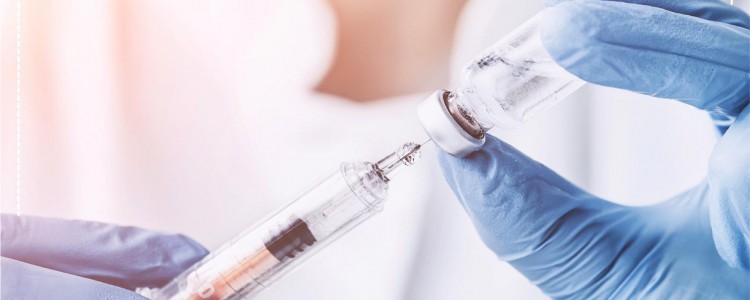
28 08 2020
Flu, caused by the influenza virus, is a contagious infectious disease that can usually continue from autumn to spring.
Flu, caused by the influenza virus, is a contagious infectious disease that can usually continue from autumn to spring. There are many subtypes of the virus and it is constantly changing.For this reason, the content of the vaccine is changed every year by the World Health Organization and it is recommended to be made again every year.
Dermatoscopy

26 08 2020
Dermatoscopy
Dermatoscopy; It is a microscopic examination of the skin superficially. It is an examination method used to diagnose nevus and different lesions on the skin.If changes, growth, irregularity, asymmetrical appearance, color change, bleeding or inflammation are observed on the surface of the nevus over time, the Dermatologist should be consulted immediately.These changes can be a sign of skin cancer called Malignant Melanoma. Early diagnosis may increase the success rate of treatment.
Choose your mask before too late

23 08 2020
Choose your mask before too late
Within the scope of Covid-19 measures, following the mask, social distance and hygiene rules protects us from serious health problems such as respiratory distress, high fever, treatment at the hospital and staying in intensive care.
What are the Symptoms of Neck Hernia?

20 08 2020
What are the Symptoms of Neck Hernia?
Symptoms in cervical disc hernia may vary depending on the duration of the disease.
The most common symptoms as follows;
Pain in the neck, back, arms and shoulders,
Numbness in the arms and hands
Neck flexion and movement problem
Loss of strength in the arms
Dizziness
Ringing in the ears
Appendicitis in Children

13 08 2020
Appendicitis in Children
Appendicitis is a painful swelling of the appendix. The appendix is a small, thin pouch about 5 to 10cm (2 to 4 inches) long. It's connected to the large intestine, where poo forms. Symptoms of appendicitis in children ;
Stomachache
High fever
Weakness
Poor appetite
Vomiting
Do People Shrınk as They Age?

13 07 2020
Do People Shrınk as They Age?
As we getting old, many changes are observed in our body.Short stature, posture disorders, hunchback are some of these changes.Osteoporosis observed as we get older, is one of the most important causes of length reduction. It is important to start timely diagnosis and treatment in order for bone loss to not progress and more important problems that may be encountered in the future.
How to Clean Your Cell Phone?

11 07 2020
How to Clean Your Cell Phone?
Earbuds or chargers should be cleaned separately. Turn off the phone.
To effectively clean your phone, remove any protective case or cover. These should also be cleaned separately before inserting the phone.
In a small spray bottle, mix a one-to-one ratio of distilled water and 70% isopropyl alcohol.
Lightly spray a lint-free microfiber cloth with the water and isopropyl mixture. Never spray the phone directly. Do not over-wet the cloth.
Use the microfiber cloth to wipe down the entire phone. Be sure to clean both the front and back.
If small areas like the space around the camera lens, attachment ports, or buttons show signs of gunk build-up, gently use a dry cotton swab or wooden toothpick to clean those areas. Once any build-up is removed, wipe down the area again with the slightly damp microfiber cloth.
Allow the phone to air dry completely for at least 15 minutes before inserting it into its case.
Fractures ın Chıldren

10 07 2020
Fractures ın Chıldren
Bone fractures in children are different from adult bone fractures because a child's bones are still growing. Also, more consideration needs to be taken when a child fractures a bone since it will affect the child in his or her growth.All children who are still growing are at risk for growth plate injuries.Specialist physician should be consulted for the correct treatment of the fractures and no disruption of the skeletal system.
Haır Loss

08 07 2020
Haır Loss
People typically lose 50 to 100 hairs a day. This usually isn't noticeable because new hair is growing in at the same time. Hair loss occurs when new hair doesn't replace the hair that has fallen out.Hair loss (alopecia) can affect just your scalp or your entire body, and it can be temporary or permanent. It can be the result of genetic, hormonal changes, medical conditions or a normal part of aging. See your doctor if you are distressed by persistent hair loss in you or your child and want to pursue treatment.
Chocolate Recıpe for World Chocolate Day

07 07 2020
Chocolate Recıpe for World Chocolate Day
“High quality chocolates produced from 85% unroasted cocoa beans without milk and sugar, contribute to the release of happiness hormone and create an antioxidant effect on the body.
Raw chocolate is made from unroasted cocoa beans.The roasting process changes the molecular structure of the cocoa beans, and reduces the enzyme content and lowers the overall nutritional value.
Material required for chocolate making;
½ cup cocoa butter (solid)
½ cup cold pressed coconut oil
½ cup (raw) organic cocoa powder
Optionally materials;
Pepper powder, nuts, almonds, dried fruits blueberries, goji berry, natural vanilla, vanilla extract, etc.
How to make;
Grate cocoa butter (the oil we make and freeze using cocoa and butter) . Put the cocoa butter and coconut oil in a heat-resistant bowl. Place this bowl in a bowl with warm water (Bain marie style). Mix the oil until smooth .Mix with ½ cup cocoa powder and other powder ingredients you want to add . Then pour the dry ingredients together with the melted fats into another bowl and mix constantly until smooth. You can also add the latest ingredients such as dried fruits and nuts to the mixture.If you want, spread the entire mixture in a thin layer or pour it into ice molds.You can wait 30 minutes in the freezer or 60 minutes in the fridge.
You will not believe how delicious the real chocolate is .
Bon appetit!
Causes of hearıng loss

04 07 2020
Causes of hearıng loss
Hearing loss is caused by many factors, most frequently from natural aging or exposure to loud noise. The most common causes of hearing loss are:
Aging
Noise exposure
Head trauma
Genetics
Malformation of outer ear, ear canal, or middle ear structure
Fluid in the middle ear from colds
Ear infection (otitis media – an infection of the middle ear in which an accumulation of fluid may interfere with the movement of the eardrum and ossicles)
Allergies
Poor Eustachian tube function
Perforated eardrum
Benign tumors
Impacted earwax
Infection in the ear canal
Foreign object in the ear
Otosclerosis (a hereditary disorder in which a bony growth forms around a small bone in the middle ear, preventing it from vibrating when stimulated by sound)
Patıents' rıghts

26 06 2020
Patıents' rıghts
Patients' rights vary in different countries and in different jurisdictions, often depending upon prevailing cultural and social norms. Patient rights are a subset of human rights. Whereas the concept of human rights refers to minimum standards for the ways persons can expect to be treated by others, the concept ofethics refers to customary standards for the ways persons should treat others. As such, rights and ethics are usually flip sides of the same coin, and behind every ‘patient right’ is one or more ethical principle from which that right is derived. What are the patients’ rights?
• Use of the service
• Informing and requesting information
• Choosing and changing healthcare staff and institution
• Privacy
• Consent
• Getting health care in a safe environment
• Respect and comfort
• Having visitors and companion
• Complaint and right to sue
Mask-Dıstance-Hygıene In Beaches and Pools

23 06 2020
Mask-Dıstance-Hygıene In Beaches and Pools
Social distance must be at least 1.5 meters in the beach and swimming area
In situations such as face-to-face and speaking with people, you should use a mask as well as maintaining social distance.
To ensure hand hygiene on the beaches, you should wash your hands with soap and water for at least 20 seconds. In the absence of water and soap you should use alcohol-based hand antiseptic or cologne containingat least 70% acohol.
People should bring their own beach towels and use them.
Materials such as goggles, snorkels and fins should be personal and should not be shared.
You should not stay on the beach and swimming areas for a long time.
Attentıon to the home accıdents!

20 06 2020
Attentıon to the home accıdents!
These days children spend more time at home and the risk of home accidents also increases. The most common home accidents; burns, blockages, drug and chemical accidents. In order to prevent home accident risks as follows;
• The plugs of equipment that may cause burns such as iron, heater, oven, teapot should be pulled out of after using and should be out of the reach of children,
•Small toys, small objects and cookies such as pistachios and hazelnuts should be kept away especially from children under 2 years of age.,
• Windows and balcony doors should be kept closed and child lock should be used if necessary,
• Medicines and detergents in the home should be kept out of the reach of children.
Stop sweatıng wıth armpıt botox!

18 06 2020
Stop sweatıng wıth armpıt botox!
Botox injections use botulinum toxin to block the nerve signals responsible for sweating, stopping the sweat glands from producing too much sweat.Sweating is normal. In fact, it’s essential. Humans need to sweat in order to regulate body temperature.But some people sweat much more than is needed.Botox, which is preferred for skin wrinkles, is also used in the treatment of many diseases.
• For excessive sweating problem, it can be applied to armpits, palms and soles.
• It can be applied in migraine treatment and muscle spasms.
• Botox can be applied for teeth grinding and discomfort caused by teeth grinding.
Hıgh Protectıon Factor Sun Creams

16 06 2020
Hıgh Protectıon Factor Sun Creams
We can protect our skin from the harmful effects of the sun with high protection factor sun creams that we make 20-30 minutes before going out. We should apply the sunscreen to all areas exposed to sunlight.If we need to be outside for a long time, we should not forget to refresh the sun cream periodically.If we need to be outside for a long time, we should not forget to refresh the sun cream periodically.
Do you know that sun rays affect cataract formatıon?

15 06 2020
Do you know that sun rays affect cataract formatıon?
The sun rays that we are exposed unprotected can damage many tissues in our body as well as negatively affect our eyes. Harmful sun rays that come into direct contact with the eyes can cause changes in the eye lens structure, causing acceleration of cataract formation.You should admit the ophthalmologist for complaints such as burning, stinging, itching and redness of the eye.The harmful effects of the sun should be minimized by using a hat and sunglasses that filter ultraviolet rays.
What Is Spınal Muscular Atrophy?

13 06 2020
What Is Spınal Muscular Atrophy?
Spinal muscular atrophy (SMA) is a disease that robs people of physical strength by affecting the motor nerve cells in the spinal cord, taking away the ability to walk, eat, or breathe. Individuals with SMA have difficulty performing the basic functions of life, like breathing and swallowing. However, SMA does not affect a person’s ability to think, learn, and build relationships with others.
Causes
SMA is a disease that's passed down through families. If your child has SMA, it's because he's got two copies of a broken gene, one from each parent.
Symptoms
• Decrease in reflexes,
• Failure to control the head
• Falling frequently
• Shaking hands
• Difficulty walking, standing and sitting
• Nutritional difficulties
What You Should Know About the Anatomy Ultrasound

07 06 2020
What You Should Know About the Anatomy Ultrasound
The anatomy scan is typically performed between 19 and 22 weeks.Other than finding out the sex of your baby (if you want to know), the ultrasound technician will be taking any measurements of your baby.What this ultrasound will look at;
Brain
Heart
Kidneys
Bladder
Stomach
Spine
Limbs
Sex organs
This ultrasound can also provide information about:
The fetal position, movement, breathing, and heart rate
An estimate of the fetal size and weight
The amount of amniotic fluid in the uterus
The location of the placenta
The number of fetuses
Fetal sex – dependent on fetal position
What ıs Phenylketonurıa (PKU)?

01 06 2020
What ıs Phenylketonurıa (PKU)?
All babies born are tested for PKU soon after birth, usually the second or third day.A blood sample is taken from a needle prick on the heel, and the phenylalanine level is measured.
If it is high, more tests are done to confirm that the baby has PKU. As soon as the diagnosis is made, the baby is given a special formula (also called a supplement) to lower the phenylalanine to a safe level.Maintaining the diet in childhood is essential to prevent damage to the growing brain. It is recommended that the diet is continued for life.
If it is not detected early, irreversible brain damage, mental retardation, hyperactivity, seizures, and autistic behavior disorders are observed. The diagnosis can be easily made with newborn screening tests.
25-31 May Internatıonal Chıldren Week wıth Leukemıa

29 05 2020
25-31 May Internatıonal Chıldren Week wıth Leukemıa
Leukemia is cancer of the body's blood-forming tissues, including the bone marrow and the lymphatic system.Many types of leukemia exist. Some forms of leukemia are more common in children. Other forms of leukemia occur mostly in adults.
Symptoms;
Fever or chills
Persistent fatigue, weakness
Frequent or severe infections
Losing weight without trying
Swollen lymph nodes, enlarged liver or spleen
Easy bleeding or bruising
Recurrent nosebleeds
Tiny red spots in your skin (petechiae)
Excessive sweating, especially at night
Bone pain or tenderness
Leukemia symptoms are often vague and not specific. You may overlook early leukemia symptoms because they may resemble symptoms of the flu and other common illnesses.
Controlled Socıal Lıfe

15 05 2020
Controlled Socıal Lıfe
We should not accept guests to our home
You should replace water loss by continuous daily fluid intake
If we think there are signs of illness, we should isolate ourselves, and if we are not alone at home, we should minimize contact in a room different from family members
We should also ask the people we contact in the past week to isolate themselves
We should not use any of our personal belongings in common
We must follow the rules of isolation and social distance
Internatıonal Thalassaemıa Day

08 05 2020
Internatıonal Thalassaemıa Day
World Thalassaemia Day is observed on every 8th of May. Thalassemia is an inherited (i.e., passed from parents to children through genes) blood disorder caused when the body doesn’t make enough of a protein called hemoglobin, an important part of red blood cells.
Thanks, Respect, Tolerance

28 04 2020
Thanks, Respect, Tolerance
We would like to thank all the healthcare professionals who worked devotedly, day and night at the expense of their lives, not only in this challenging process, but also for their efforts. We wish the end of verbal or physical violence against to healthcare workers.
What should we be careful about when we are at home?

19 04 2020
What should we be careful about when we are at home?
You should air your house frequently
You should not use different chemical cleaning products at the same time
After cleaning, you should wash your hands with soap and water, with the right hand washing method
If you came home from outside, you should leave your shoes out of the door
After entering the house, you should not touch any places without washing your hands
World Hemophılıa Day
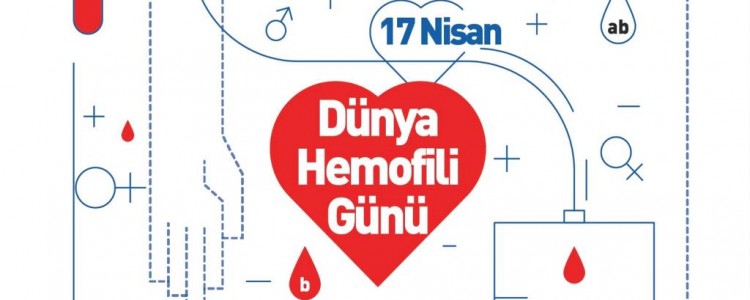
17 04 2020
World Hemophılıa Day
Every year on 17 April World Haemophilia Day is recognised worldwide to increase awareness of haemophilia, von Willebrand disease and other inherited bleeding disorders.
Hemophilia patients;
Should go to the doctor regularly
Should not use drugs without the doctor's advice
When referring to another physician, they should state that they have hemophilia disease
They should follow doctor's advice during the treatment
What Is Intubatıon and Why Is It Done?

16 04 2020
What Is Intubatıon and Why Is It Done?
Intubation is a standard procedure that involves passing a tube into a person’s airway. Doctors often perform before surgery or in emergencies to give medicine or help a person breathe.
Intubation is done because the patient cannot maintain their airway, cannot breathe on their own without assistance, or both. They may be going under anesthesia and will be unable to breathe on their own during surgery, or they may be too sick or injured to provide enough oxygen to the body without assistance.
Growth Monıtorıng ın Chıldren

15 04 2020
Growth Monıtorıng ın Chıldren
Growth monitoring is widely accepted and strongly supported by health professionals, and is a standard component of community paediatric services throughout the world.Weight is an important parameter for growth, and weighing a baby or child is a routine part of care. By looking at your baby’s growth curve and weight for his age, your doctor will be able to see if the growth is within the normal range, or if there is any risk of over- or under-nutrition.Weight for age is not the only important parameter. Weight for height is equally as important in screening for stunting. In the earlier stages of life, length is used rather than height.
If possıble, use the onlıne shoppıng for your shoppıng wıthın the scope of coronavırus measures

11 04 2020
If possıble, use the onlıne shoppıng for your shoppıng wıthın the scope of coronavırus measures
If you need to go out for your shopping;
You have to go shopping one person and shop as fast as possible
During shopping, we sholud follow the rules of social distance
We should choose the products with our eyes, not with our hands
During shopping, we should not touch our face and make sure to disinfect our hands frequently
We should take our own market bags from our home to shopping
Correctly Known Mıstakes!
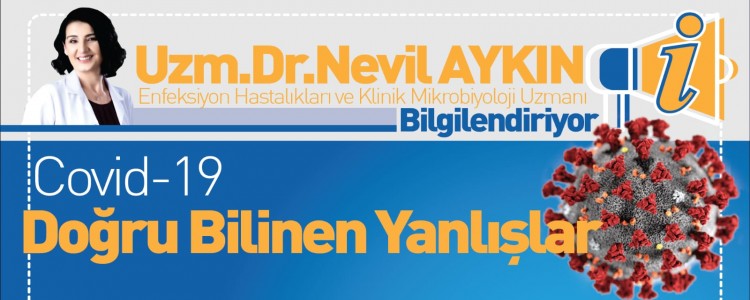
10 04 2020
Correctly Known Mıstakes!
Salt water prevents the virus: There is no scientific data to show that salty water is blocked the virus.
Surgical masks can be washed and reused :Surgical masks lose their protective function when washed.
Only hand washing is sufficient to protect against coronavirus: Hand washing is important for protection from coronavirus, but other protection recommendations should also be considered.
8-14th Aprıl Heart Health Week

08 04 2020
8-14th Aprıl Heart Health Week
To Protect Your Heart Health:
Stay healthy.
Be active and control your heart health.
Tobacco say "NO".
Limit alcohol consumption.
Keep your body weight healthy.
Keep your blood pressure under control.
Make regular blood pressure measurements.
They need more attentıon now!

05 04 2020
They need more attentıon now!
Please do not forget to call our family elders who are in the coronavirus risk group.We should remind that we are with our valuable elders who are always with us with their experience and knowledge, and we should approach them with respect and compassion in this process.
Attentıon to waste of water!

03 04 2020
Attentıon to waste of water!
Here are a few ways that you could be wasting water without realising it, and what you can do about it.
You wait for the tap water to get cold during the summer.
You hose down your driveway or patio instead of sweeping it.
You put off repairing leaky faucets.
You run your dishwasher when it's not full.
You throw just a few items of clothing in the washing machine.
You leave the faucet running while you brush your teeth.
World Autısm Awareness Day

02 04 2020
World Autısm Awareness Day
World Autism Awareness Day is an internationally recognized day on 2 April every year.There is no better way to celebrate this day than by becoming aware of the characteristics of people with this condition and how all of us can do better to increase our own understanding and promote kindness.
Down Syndrome

21 03 2020
Down Syndrome
This first cell has 46 chromosomes, 23 from the mother and 23 from the father. All the instructions for how the child will grow are in the genes on these chromosomes. Each cell of the body will contain exact copies of the 23 pairs of chromosomes that were in the first cell that was formed by the egg and sperm.Down's syndrome occurs in babies born with extra chromosome 21 material in their cells. Down's syndrome is also known as trisomy 21. Trisomy 21 means there are 3 copies of chromosome 21.
Pulmonary embolısm

10 03 2020
Pulmonary embolısm
A pulmonary embolism is a blockage in the pulmonary artery, which supplies the blood to the lungs. It is one of the most common cardiovascular diseases .
Symptoms of pulmonary embolism include:
Chest pain, a sharp, stabbing pain that might become worse when breathing in
Increased or irregular heartbeat
Dizziness
Difficulty catching breath, which may develop either suddenly or over time
Rapid breathing
A cough, normally dry but possibly with blood, or blood and mucus
8th of March Internatıonal Women's Day

08 03 2020
8th of March Internatıonal Women's Day
We celebrated the 8th of March International Women's Day for our female employees with an event organized by our hospital management. On behalf of our management, our Hospital Operation Director deputy Mr. Ali Yıldız presented flowers to our unit representative female employees.
Colon (Colorectal) Cancer

05 03 2020
Colon (Colorectal) Cancer
As in other cancers, one of the most important steps in Colon (Colorectal) Cancer is regular screening.
Things to consider to prevent cancer ;
- Staying healthy and maintaining weight
- Eating fresh fuits and vegetables
- Increasing the consumption of foods with high fiber content.
- Doing moderate physical activity for 30-60 minutes a day
- Not using alcohol and not smoking
Colonoscopy screening is recommended to people aged 50-70 every 10 years.
2019 Novel Coronavırus (COVID-19)

04 03 2020
2019 Novel Coronavırus (COVID-19)
Cover mouth and nose with flexed elbow or tissue when coughing or sneezing. Dispose of used tissue immediately.
Avoid close contact with anyone who has cold or flu-like symptoms.
Seek medical care early if you or your child has a fever, cough or difficulty breathing.
Wash your hands frequently using soap and water or an alcohol-based hand rub.
What is the best way to wash hands properly?
Step 1: Wet hands with running water
Step 2: Apply enough soap to cover wet hands
Step 3: Scrub all surfaces of the hands – including back of hands, between fingers and under nails – for at least 20 seconds.
Step 4: Rinse thoroughly with running water
Step 5: Dry hands with a clean cloth or single-use towel
Training for 2019 Novel Coronavırus (COVID-19)

27 02 2020
Training for 2019 Novel Coronavırus (COVID-19)
Our Hospital, Infectious Diseases and Clinical Microbiology Specialist. Nevil Aykın gave training to our hospital staff on novel coronavirus (COVID-19), measures to be taken against the virus, and what to do in potentially suspicious cases.
What Is Intra-artıcular InJectıon?

26 02 2020
What Is Intra-artıcular InJectıon?
An intra-articular injection is a term used to describe a shot delivered directly into a joint with the primary aim of relieving pain. Corticosteroids (steroids) were the first substances used for this purpose. Other types of drug are now commonly used including local anesthetics, hyaluronic acid, and even Botox.An intra-articular injection is typically given when the pain has not responded to more conservative treatments including pain relievers, oral anti-inflammatory drugs, and physical therapy.
Are you breathıng properly ?

25 02 2020
Are you breathıng properly ?
Not breathing properly can bring health problems . Breathing incorrectly ;
- It can cause narrowing of blood vessels and correspondingly high blood pressure.
- Oxygen deficiency can cause our muscles to become stiff and tense.
- Failure to get enough air for our body can cause faster breathing.
- Insufficient oxygen for your heart can cause the blood to not be pumped properly and the blood circulation in the body to be badly affected.
- Our brain can work slower in oxygen deficiency.
For breathing properly ; should breath deeply and breath through the nose . Also exhalation duratin should be long.
Have you notıced that you feel more sleepy and tıred in overcast weather and feel happier and fıt ın sunny weather?

20 02 2020
Have you notıced that you feel more sleepy and tıred in overcast weather and feel happier and fıt ın sunny weather?
Have you noticed that you feel more sleepy and tired in overcast weather and feel happier and fit in sunny weather?The hormone Serotonin, also called the hormone of happiness, is secreted less with the decrease of the sun's rays, and the hormone melatonin increases in the dark.
February 9th World Quıt Smokıng Day

09 02 2020
February 9th World Quıt Smokıng Day
• An individual who smokes for more than 20 years his body accumulates about 7 kg of tar
• Each breath taken from cigarettes kills about 50 thousand cells in the body.
• The risk of heart disease in smokers is 2 to 5 times higher than those who do not use.
• Cause to , calcium,vitamin D, Vitamin C and Iron deficiency.
• 96% single cause of lung cancer is smoking.
• Smoking is one of the main risk factors in bladder, stomach and kidney cancers.
Intestınal ınfectıous dıseases

06 02 2020
Intestınal ınfectıous dıseases
Usually the abdomen gets cold or thought to result from consuming cold drinks, commonly known as a cold in the stomach, is an infectious intestinal disease caused by viruses.
The first symptoms include diarrhea and nausea, and if it continues for a long time, you should consult a specialist.
The effect of hıgh blood pressure on the eye

02 02 2020
The effect of hıgh blood pressure on the eye
The effect of high blood pressure on the eye;
Hypertension, known as high blood pressure, can damage eye vessels in the future, as well as other vessels in the body.
Regular eye examination is required to control the course of the disease and to what extent hypertension damage the body.
Adenoıd

31 01 2020
Adenoıd
Adenoid;It is a tissue that produces antibodies against microbes that reach the upper respiratory tract between the nose and throat.
It may also bring health problems such as ;
Adenoid growth in children;
Growth retardation,
Loss of appetite
Constant mouth-breathing,
Snoring or sleep apnea and hearing loss.
Learnıng dısorders due to vısual dısorders

23 01 2020
Learnıng dısorders due to vısual dısorders
Reading, writing and learning difficulties in school-age children may be related to vision problems.It is observed that children who cannot see the blackboard have difficulty in understanding the lesson and lose interest in the lessons.You can consult a doctor without losing time about visual impairments, which is one of the most important health problems that directly affect your child's social life and success in school life.
For thıs reason, dıabetıcs should have an eye examınatıon at least once a year to protect eye health.

21 01 2020
For thıs reason, dıabetıcs should have an eye examınatıon at least once a year to protect eye health.
Diabetes can lead to serious health problems when not taken under control. Diabetes-related vision disorders are one of them. While the damage caused by diabetes in the eyes can lead to loss of vision in the future, precautions can be taken by noticing in advance with regular examinations. For this reason, diabetics should have an eye examination at least once a year to protect eye health.
Cırcumcısıon

20 01 2020
Cırcumcısıon
Performing the circumcision procedure in appropriate conditions and by physicians who have received medical education and specialist in their own field,minimizes complications that may occur. Due to the cold weather and the restriction of children's activities, half-term holidays are one of the best times for circumcision.
Attentıon to slıppery floors

13 01 2020
Attentıon to slıppery floors
Cold weather, snow and rain can make the floor slippery.Slippery floors can cause falls, but can also cause fractures and dislocations on the joints, elbows and shoulders, and wrists when dropped. After fall, a specialist physician should be consulted immediately.
Whıte Cane

07 01 2020
Whıte Cane
Vision problems can be congenital or occur later. The causes of subsequent vision loss include;
advanced stage diabetes, eye pressure, cataract, yellow spot disease, work and traffic accidents.
Conditions such as decreased vision, narrowing of the visual field and blurred vision accompany the diseases that cause significant visual damage.It is important for patients with this type of complaint to consult a physician for early diagnosis and treatment for keep visual health.
Fıght wıth Tuberculosıs Traınıng Week

05 01 2020
Fıght wıth Tuberculosıs Traınıng Week
Tuberculosis, which can be treated with early diagnosis and regular treatment, is an infection that can be seen in more than one organ and occurs mostly in the lung.Tuberculosis symptoms usually begin mildly and progress slowly, so delays in consulting to the doctor may be experienced.Among the patient complaints,
- prolonged dry cough coughing up blood night sweats loss of appetite weight loss weakness chest pains high fever in the evening in advanced cases, shortness of breath may occur.
Patients with such complaints should consult a specialist for a definitive diagnosis.
Attentıon to heart health ın cold weather !

03 01 2020
Attentıon to heart health ın cold weather !
Cold weather can cause vasoconstriction and heart diseases.In cold weather; Inactivity, nutrition, fluid consumption, sleep patterns and care to maintain the body's temperature by taking care of our clothes, are among the measures we can take to protect our heart health.
Hastanemiz Hemşirelik Hizmetleri Direktörü Gamze ONAR BAŞARANGİL, Etkin Koleji öğrenci ve öğretmenlerine “El Hijyeni” konulu seminer verdi.

26 12 2019
Hastanemiz Hemşirelik Hizmetleri Direktörü Gamze ONAR BAŞARANGİL, Etkin Koleji öğrenci ve öğretmenlerine “El Hijyeni” konulu seminer verdi.
Hastanemiz Hemşirelik Hizmetleri Direktörü Gamze ONAR BAŞARANGİL, Etkin Koleji öğrenci ve öğretmenlerine “El Hijyeni” konulu seminer verdi. Soru-cevap ile devam eden seminer verimli bir şekilde sona erdi.
Tepebaşı Belediye Başkanı Ahmet ATAÇ ve Ticaret Odası Başkanı Metin GÜLER standımızı ziyaret etti.

21 12 2019
Tepebaşı Belediye Başkanı Ahmet ATAÇ ve Ticaret Odası Başkanı Metin GÜLER standımızı ziyaret etti.
Lösemili Çocuklara destek olmak adına düzenlenen Mutluluk Festivali’nin ikinci gününde Tepebaşı Belediye Başkanı Ahmet ATAÇ ve Ticaret Odası Başkanı Metin GÜLER standımızı ziyaret ederek hastanemizin hizmetleri ve tedavi yöntemleri ile ilgili Hastane İşletme Direktörümüz Derya DEMİR’den bilgi aldılar.
Dyt.Lalenur BALCI’dan, Kilonuzu,vücut yağ-kas-su oranınızı öğrenebilir ve size en uygun beslenme listenizi alabilirsiniz.
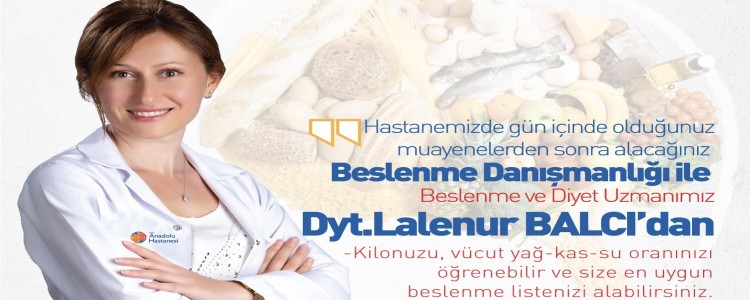
21 12 2019
Dyt.Lalenur BALCI’dan, Kilonuzu,vücut yağ-kas-su oranınızı öğrenebilir ve size en uygun beslenme listenizi alabilirsiniz.
Hastanemizde gün içinde olduğunuz muayenelerden sonra alacağınız Beslenme Danışmanlığı ile Beslenme ve Diyet Uzmanımız Dyt.Lalenur BALCI’dan,
Kilonuzu,vücut yağ-kas-su oranınızı öğrenebilir ve size en uygun beslenme listenizi alabilirsiniz.
Hastanemiz Mutluluk Festivali’nde !

20 12 2019
Hastanemiz Mutluluk Festivali’nde !
Üç gün sürecek olan ve Lösemili Çocuklara destek olmak adına düzenlenen festivalin açılışı bugün, Ticaret Odası Başkan Vekili Süleyman Kutlu, Ticaret Odası Başkanı Metin GÜLER’in eşi Nilüfer Güler,Hastane İşletme Direktörümüz Derya Demir, Kanatlı AVM Genel Müdürü Zehra Kutlu, Ticaret Odası Yönetim Kurulu Üyesi Emre Demir, Gönül Gökmeydan ve Festival Kurucusu Ebru Demir tarafından gerçekleştirildi.
Hastanemiz Hasta Hizmetleri Birimi, Hemşirelik Hizmetleri Birimi ve Kurumsal İletişim ve Pazarlama Biriminden ekip arkadaşlarımızın yer aldığı standımıza uğrayan ziyaretçilerimizin şeker ve tansiyon ölçümü gerçekleştirilirken, minik misafirlerimize hediyeler dağıtıldı.
Hastalıklarınızın bulunduğunuz bölgeden de kaynaklı olabileceğini hiç düşündünüz mü ?

16 12 2019
Hastalıklarınızın bulunduğunuz bölgeden de kaynaklı olabileceğini hiç düşündünüz mü ?
Have you ever thought that your illnesses may also have originated from your region?
You may experience illnesses from wastewater in your environment also gases and dust from building structures, or self-repeating illnesses.
anestezi teknisyen ve teknikerlerimizin gününü kutladık.

13 12 2019
anestezi teknisyen ve teknikerlerimizin gününü kutladık.
13 Aralık Anestezi Teknisyen ve Teknikerleri günü dolayısı ile Hastanemiz Başhekimi Uzm.Dr.Levent BİLİR ve Hemşirelik Hizmetleri Direktörü Gamze ONAR BAŞARANGİL katılımıyla anestezi teknisyen ve teknikerlerimizin gününü kutladık.
Partnershıp Summıt 2019

09 12 2019
Partnershıp Summıt 2019
We host our English partners on Partnership Summit 2019. We had signed with them an agreement for follow up after operations when English patients return to their country.
Projects and the details of the agreement were talked in summit with Dietitian Neshe Targen, Dietitian Vandhana Patel , Nurse Rachel Ozigbo, Professor M.D.Ishaq Sauid ve Shadman Sharafbainy with participation owners of our hosptal's Head Physician M.D. Levent Bilir and General Director Surgeon M.D. Cenk Soğukpınar.
At the summit, city tours made and traditional foods were eaten, our British Partners returned to their countries amazed with hospital, employees and our city.
Hastanemizin hizmetleri ve tedavi yöntemleri ile ilgili bilgilendirme amaçlı TÜLOMSAŞ’ ta idik.

28 11 2019
Hastanemizin hizmetleri ve tedavi yöntemleri ile ilgili bilgilendirme amaçlı TÜLOMSAŞ’ ta idik.
Hastanemizin hizmetleri ve tedavi yöntemleri ile ilgili bilgilendirme amaçlı TÜLOMSAŞ’ ta idik. TÜLOMSAŞ çalışanları , Check-up biriminden Tuğçe KARABAĞ ve Kurumsal İletişim ve Pazarlama biriminden Suna ÖZŞENDİL tarafından bilgilendirildi.
29 Kasım Dünya Tıbbi Sekreterler Günü

28 11 2019
29 Kasım Dünya Tıbbi Sekreterler Günü
29 Kasım Dünya Tıbbi Sekreterler Günü dolayısı ile Hastane Genel Direktörümüz İbrahim Cenk SOĞUKPINAR, Hastane İşletme Direktörümüz Derya DEMİR,Hasta Hakları Yöneticimiz Duygu DÖNMEZ, Yönetici Asistanı İmmihan ŞANLI ve Tıbbi Sekreterlerimizin katılımıyla 29 Kasım Dünya Tıbbi Sekreterler Günü’nü kutladık.
Göğüs Hastalıkları Uzmanı, Uzm.Dr.Zeynep SÖNMEZ ÇELİK, “ Akciğer kanseri nedir? ” hakkında bilgilendirdi.

27 11 2019
Göğüs Hastalıkları Uzmanı, Uzm.Dr.Zeynep SÖNMEZ ÇELİK, “ Akciğer kanseri nedir? ” hakkında bilgilendirdi.
AKCİĞER KANSERİ
Dünyada en ölümcül kanser türü olarak bilinen akciğer kanseri vücutta meydana gelen değişiklikleri fark edilip hekime başvurulmasıyla erken dönemde tespit ve tedavi edilebilmektedir.
Her yıl 1 milyondan fazla kişi bu hastalıktan hayatını kaybetmektedir. Erkeklerde daha sık görülen bu kanser sigara içiminin bayanlar arasında da yaygınlaşmasının ardından kadınlarda da akciğer kanseri teşhisleri artmaktadır.
Akciğer kanserinde erken tanı hayat kurtarıcıdır. Ziya kanser hücreleri hızlıca kemik, beyin, karaciğer, lenf bezleri gibi birçok organa yayılım gösterebilmektedir.
Belirtileri nelerdir?
- Nefes darlığı, hırıltılı solunum
- Geçmeyen şiddeti giderek artan öksürük
- Kanlı balgam
- İştah azalması ve hızlı kilo kaybı
- Göğüs ağrısı,sırt ağrısı
- Ses kısıklığı
- Yutma güçlüğü
Akciğer kanseri yaş ilerledikçe sıklığı artan bir kanser türüdür. Ailesinde akciğer kanseri olanlarda risk artmaktadır. Sigara içme yılı ve paket sayısı arttıkça riskin daha yükseldiği tespit edilmiştir.
Kanser 45 yaş altında nadir gözlemlenmektedir. Genellikle 50-70 yaş arası hastalar tanı almaktadırlar.
Akciğer kanseri riskini arttıran Faktörler?
Akciğer kanserinin %96 tek sebebi sigaradır.
Ailesinde Akciğer kanseri hikayesi olanlarda risk artmaktadır.Özellikle de sigara kullananlarda risk katlanarak artmaktadır.
Mesleki maruziyet, kimyasal gaz, asit ve dumanlara maruz kalma, asbest maruziyeti.
İnşaat sektörü, tekstil sektörü, demir çelik endüstrisi, plastik sanayii, boya ve lastik endüstrisinde çalışanlarda vb. risk artmaktadır.
Yapılan çalışmalar zemin katta yaşayanlarda yer altından gelen zehirli gazlardan dolayı Akciğer kanseri riskinin arttığı gözlemlenmiştir.
Akciğer kanseri önlenebilir ve erken tespit edildiğinde başarıyla tedavi edilebilen bir kanser türüdürdür.
Neler Yapmalıyız?
Yukarıda belirtilen bulgulardan biri varsa hemen hekimimize başvurmalıyız .
Ailesinde Akciğer kanseri öyküsü olanlar düzenli aralıklarla PA AC grafi ile kontrol yaptırmalı .
Sigarayı bırakmalı ve içilen ortamlardan uzak durmalılar .
Sigarayı Bırakmakla Birlikte Risk %50 Azalmaktadır !!
Akciğer kanseri önlenebilir bir hastalıktır .
Sigara içilen ortamdan uzak durmalıdır .
Riskli ortamlarda çalışanların önlemlerini almaları gerekir .
Doğru beslenme Akciğer kanseri riskini azaltmaktadır. Bol meyve,sebze tüketimi A vitamini ve B karotenden zengin beslenmek önemli .
Sağlıklı ve güzel gülüşlerin arkasında yer alan tüm diş hekimlerinin Dünya Diş Hekimleri Günü’nü ve Ağız Diş Sağlığı Haftası’nı kutluyoruz.

22 11 2019
Sağlıklı ve güzel gülüşlerin arkasında yer alan tüm diş hekimlerinin Dünya Diş Hekimleri Günü’nü ve Ağız Diş Sağlığı Haftası’nı kutluyoruz.
Sağlıklı ve güzel gülüşlerin arkasında yer alan tüm diş hekimlerinin Dünya Diş Hekimleri Günü’nü ve Ağız Diş Sağlığı Haftası’nı kutluyoruz.
KOAH; Kronik Obstrüktif(tıkayıcı) Akciğer Hastalığıdır.

20 11 2019
KOAH; Kronik Obstrüktif(tıkayıcı) Akciğer Hastalığıdır.
KOAH; Kronik Obstrüktif(tıkayıcı) Akciğer Hastalığıdır. Tedavi edilebilir bir hastalıktır.
•Nefes Darlığı
•Öksürük ve balgam
•Yorgunluk,halsizlik
•Göğüs sıkışması,hırıltı
gibi şikayetleriniz var ise KOAH olabilirsiniz. Belirtilerin olduğunu düşünüyorsanız Göğüs Hastalıkları Polikliniğine başvurabilirsiniz.
17 Kasım Dünya Prematüre Günü

17 11 2019
17 Kasım Dünya Prematüre Günü
Normal gebelik süresi 38-42 hafta arasındadır ve 37. Haftadan önce doğan bebekler prematüre olarak adlandırılır.Prematüre bebeklerin özellikle ilk dönemlerdeki bakımı daha fazla hassasiyet gerektirmektedir.
Erken dünyaya gelen bu bebekler, zamanında doğan bebeklere göre birçok açıdan riskli bir durumda hayata başlamaktadır. Prematüre bebekler için önemli konulardan biri nörolojik ve fiziksel gelişimlerinin normal olarak devam etmesidir. Bunu sağlamak için bebeğin aylık boy, kilo ve baş çevresi artışının ve nörolojik gelişiminin yakından takip edilmesi kritik önem taşımaktadır.Bu nedenle prematüre doğan bebeklerin bakımı için bebeğin doğduğu hastanede yenidoğan yoğun bakımı bulunmalıdır. Bu konuda bilgi ve deneyim sahibi yenidoğan hemşireleri tarafından bebeğin bakımı gerçekleştrilmelidir. Prematüre doğan bebeklerin evde bakımı mümkün değildir. Yenidoğan yoğun bakımı gözetiminde bebeğin süreci tamamlaması , ailelerin de psikolojik olarak desteklenmesi, bilgilendirilmesi ve eğitimi, profesyonel sağlık çalışanları tarafından gerçekleştirilmelidir.
Prematüre bebeklerin beslenmesi ve bakımı konusunda insanları bilgilendirmek amacıyla 17 Kasım Dünya Prematüre Günü olarak kutlanmaktadır.
Dıabetes ıs an ıncreasıng publıc health problem ın our country as well as ın the world.

14 11 2019
Dıabetes ıs an ıncreasıng publıc health problem ın our country as well as ın the world.
Diabetes is an increasing public health problem in our country as well as in the world. Diabetes is one of the most common diseases in the world. As with other chronic diseases, diabetic patients should have regular doctor control and regulate their nutrition and do regular exercise.
Dyt.Lalenur BALCI , 14 Kasım Dünya Diyabet Günü dolayısı ile Gazi Mesleki ve Teknik Anadolu Lisesi’nde seminer verdi.

14 11 2019
Dyt.Lalenur BALCI , 14 Kasım Dünya Diyabet Günü dolayısı ile Gazi Mesleki ve Teknik Anadolu Lisesi’nde seminer verdi.
Hastanemiz Beslenme ve Diyet Uzmanı Dyt.Lalenur BALCI , 14 Kasım Dünya Diyabet Günü dolayısı ile Gazi Mesleki ve Teknik Anadolu Lisesi’nde öğrenci ve öğretmenlere Diyabet konulu seminer verdi. Soru-cevap ile devam eden seminer verimli bir şekilde sona erdi.
world pneumonıa day

12 11 2019
world pneumonıa day
Pneumonia is a respiratory system infection that affects the lungs. Pneumonia can be caused by bacteria, viruses and fungi.The most common complaints of high fever that not bring down within three days, chest pain and cough. Patients with such complaints should consult a Chest Disease or Infectious Disease physician.
KASIM AYI FORD OTOSAN AYLIK UZMAN HEKİM SEMİNERİ

12 11 2019
KASIM AYI FORD OTOSAN AYLIK UZMAN HEKİM SEMİNERİ
Hastanemiz ve Ford Otosan işbirliği ile gerçekleştirilen aylık uzman hekim seminerlerinin Kasım ayı konuğu Üroloji Uzmanı Op.Dr.Mehmet HAMARAT oldu. Testis Hastalığı, Prostat Hastalığı ve Böbrek Taşı konularında bilgilendiren hekimimiz, seminer sonunda Ford Otosan çalışanlarının sorularını cevapladı.
Dünya Radyoloji Günü’nü kutladık

08 11 2019
Dünya Radyoloji Günü’nü kutladık
Radyoloji bölümü; hastalıkların teşhis ve tedavi sürecenin önemli parçalarından biridir.Hastanemiz Başhekimi Uzm.Dr.Levent BİLİR, Hastanemiz Genel Müdürü Op.Dr.İbrahim Cenk SOĞUKPINAR, Hastane İşletme Direktörümüz Derya DEMİR, Hastanemiz Yönetici Asistanı İmmehan ŞANLI,Radyoloji hekimlerimiz Uzm.Dr.Musa ATASEVEN,Uzm.Dr.Okay Yaşar SARITAŞ,Uzm.Dr.Ahmet UYSAL, radyoloji tekniker ve teknisyenlerimizin katılımıyla Dünya Radyoloji Günü’nü kutladık.
Sağlıkta İletişim Sempozyumu’na hastanemiz İşletme Direktörü Ezgi OKTAŞ ve Hemşirelik Hizmetleri Direktörü Gamze ONAR BAŞARANGİL katılım gösterdiler

07 11 2019
Sağlıkta İletişim Sempozyumu’na hastanemiz İşletme Direktörü Ezgi OKTAŞ ve Hemşirelik Hizmetleri Direktörü Gamze ONAR BAŞARANGİL katılım gösterdiler
Anadolu Üniversitesi İletişim Bilimleri Fakültesi’nin ev sahipliğinde bu yıl 5. si gerçekleştirilen Sağlıkta İletişim Sempozyumu’na hastanemiz İşletme Direktörü Ezgi OKTAŞ ve Hemşirelik Hizmetleri Direktörü Gamze ONAR BAŞARANGİL katılım gösterdiler. Sağlık sektöründe iletişimin önemini konu alan sempozyumda akademisyenler ve hekimlerin güncel araştırma konuları aktarıldı.
3-9 Kasım Organ Nakli Haftası

04 11 2019
3-9 Kasım Organ Nakli Haftası
Her yıl binlerce kişi organ yetmezliğinden hayatını kaybetmektedir. Bağışladığınız her organ ile uzun bekleyişler son bulabilir. İlgili kurumların organ bağışı birimlerinden detaylı bilgi alabilir ve bağışladığınız her organ ile geleceğe umut olabilirsiniz.
2-8 Kasım Lösemili Çocuklar Haftası

02 11 2019
2-8 Kasım Lösemili Çocuklar Haftası
Çocukluk çağındaki lösemi hastalığının ilk belirtileri;
• Solukluk ve halsizlik
• Burun ve diş eti kanamaları
• Ateş
• İştahsızlık,zayıflama
• Kansızlık
• Cilt altında kanamalar
• Eklem veya kemik ağrıları
Ayrıca yayıldığı organlara ait belirtiler, örneğin baş ağrısı, kusma, karın ağrısı, görme bozuklukları önem taşıyabilir.
Bu tür şikayetleri olan çocuklar için mutlaka uzman hekime başvurulmalıdır.
Bu belirtiler sonucunda yapılan kan, kemik iliği, hücre tipini belirleme ve genetik tetkikler sonucunda kesin tanı konulabilir. Uzmanlarca yapılan muayenede çoğunlukla karaciğer ve dalak büyümesi, lenf bezlerinde genişleme, kanama bulguları tespit edilebilir.
November ıs Lung Cancer Awareness Month of

01 11 2019
November ıs Lung Cancer Awareness Month of
November is Lung Cancer Awareness Month of
For healthy living, healthy breathing and healthy lungs;
• Avoid tobacco and tobacco products
• Take care of healthy nutrition and exercise regularly
• Have your health check-up regularly.
Prof.Dr.Bekir YAŞAR , Ford Otosan çalışanları için “Meme Kanseri “ üzerine seminer verdi

23 10 2019
Prof.Dr.Bekir YAŞAR , Ford Otosan çalışanları için “Meme Kanseri “ üzerine seminer verdi
Hastanemiz Genel Cerrahi Uzmanı Prof.Dr.Bekir YAŞAR , Ford Otosan çalışanları için “Meme Kanseri “ üzerine seminer verdi. Soru cevap ile devam eden seminer verimli bir şekilde sona erdi.
osteoporosıs

20 10 2019
osteoporosıs
Symptoms of osteoporosis include; low back and neck pain, shortening of the bones due to bending of the bones over time, forward and hump body posture, back and waist pain, hip, wrist and spine fractures. To prevent osteoporosis; You can eat foods rich in vitamin D, calcium and protein.
Geleneksel VitrA İş Sağlığı & Güveliği Günleri etkinliğine Özel Eskişehir Anadolu Hastanesi olarak katılım gösterdik.

18 10 2019
Geleneksel VitrA İş Sağlığı & Güveliği Günleri etkinliğine Özel Eskişehir Anadolu Hastanesi olarak katılım gösterdik.
Geleneksel VitrA İş Sağlığı & Güveliği Günleri etkinliğine Özel Eskişehir Anadolu Hastanesi olarak katılım gösterdik.
İş Sağlığı ve Güvenliğinde yeni yaklaşımlar, deneyim yaşayarak öğrenme, sanal gerçeklik, iş ekipmanlarının güvenli kullanımı, Arama-Kurtarma-Yangın konusunda bilinçlendirme, kişisel koruyucular, sağlıklı yaşam-koruyucu hekimlik ve simülasyonların sergilendiği
etkinlikte, hastanemizin güçlü hekim kadrosu, hizmet ve tedavileri Eczacıbaşı VitrA çalışanlarına anlatıldı.
Uzm.Dr.Nevil AYKIN , Arçelik Buzdolabı çalışanları için “Soğuk algınlığı ve Grip “ üzerine seminer verdi.

16 10 2019
Uzm.Dr.Nevil AYKIN , Arçelik Buzdolabı çalışanları için “Soğuk algınlığı ve Grip “ üzerine seminer verdi.
Hastanemiz Enfeksiyon Hastalıkları ve Klinik Mikrobiyoloji Uzmanı Uzm.Dr.Nevil AYKIN , Arçelik Buzdolabı çalışanları için “Soğuk algınlığı ve Grip “ üzerine seminer verdi. Soru cevap ile devam eden seminer verimli bir şekilde sona erdi.
16 Ekim Dünya Anestezi Günü

16 10 2019
16 Ekim Dünya Anestezi Günü
Cerrahi operasyonların güvenli ve sağlıklı olabilmesi, hastanın operasyon sırasında acı ve ağrı duymasını engellemek amacı ile ilaç kullanılarak vücudun uyuşturulması amacıyla yapılan uygulamalara anestezi denmektedir.
Ameliyatın önemli parçalarından biri olan anestezi , cerrahi müdahalelerin yerine getirilmesinde önemli rol oynamaktadır.
Anestezi Uzmanlarımızın , anestezi tekniker ve teknisyenlerimizin Dünya Anestezi Günü’nü kutluyoruz.
world arthrıtıs day

12 10 2019
world arthrıtıs day
ARTHRITIS, commonly known as joint rheumatism, is a disease that causes joint pain and joint stiffness caused by cartilage destruction.Knee joint, spine, finger joints, joint root of Big toe is more common as time pass and more common in women. In rheumatic diseases, the earlier the diagnosis is made and the sooner the treatment is started, the higher the success rate. Therefore, if you have swelling of your joints and you feel constant pain, you can consult a specialist.
world gırls day

11 10 2019
world gırls day
The 11th of October, International Day of the Girl has been declared in order to raise awareness of the discrimination and violence that girls face in different parts of the world due to their gender.
We should take care of all of our children, give equal education and support them so that they can become strong individuals who will contribute to the development of society.
It ıs the most common type of cancer ın women. Durıng lıfe, one ın 8 women have breast cancer.

10 10 2019
It ıs the most common type of cancer ın women. Durıng lıfe, one ın 8 women have breast cancer.
It is the most common type of cancer in women. During life, one in 8 women have breast cancer.The most important risk factor is undoubtedly being a woman, Breast cancer can also be seen in men and this rate is less than 1% of the incidence in women.
Breast cancer is more common in developed countries. Japan is an exception. The reason for this is the excess consumption of omega3-containing fish in Japanese cuisine.Such that the settled Japanese in the United States, after a few generations, this rate is similar to that seen in other US citizens.The most blamed in this regard are obesity and the consumption of fatty fastfoods.Especially in postmenopausal obese women, breast cancer is more common than others.
although breast cancer is more common after 40-50 years of age and advanced age is an important risk factor, unfortunately, we see much more than expected in our country at young ages.
Today, alcohol consumption is considered among the most important risk factors.
Hormones are classic risk factors.These include factors such as having given birth to her first child at an advanced age, more importantly, never having given birth, the first menstruation is too early , menopause at an advanced age, starting birth control pills at an early age and using them for a long time, and using estrogen + progesterone hormones together to alleviate menopausal complaints of menopausal women.Cancer in one breast poses a risk for cancer in the other breast (simultaneously or at different time).
In the meantime, genetic studies show that BRCA I (breast cancer I) genes with positive BRCA II (breast cancer II) genes are very likely to have breast cancer.Other organ cancers may also be more common in breast cancer patients with genetic transmission characteristics at the same time or in another time period.For example ; Breast cancer - ovarian cancer, breast cancer - colon cancer, breast cancer - brain tumor.
Such hereditary cancers occur at a younger age and are more likely to be bilateral (at the same time or at different times).
Physical examination and radiological evaluation are essential for diagnosis. However, the definitive diagnosis is made by pathological examination of the part taken from the breast.
In physical examination, we can group the findings as early and late periods with two headings. Although breast tumor can be seen all over the breast, the most common part is the upper outer quadrant.
There are early important symptoms ,these are, a slight pitting on the breast skin , nipple bloody discharge , image like eczema around nipple.
In the elderly, tissues located behind the nipple can escape into the nipple because it is atrophied. But when nipple is pulled by hand it comes out. This is a normal physiological condition.However, in breast cancer nipple does not come out.
The presence of palpable mass on palpate is a very important finding, but not every palpable mass is a cancer.Especially benign tumors called fibroadenoma in young people, middle and older ages, cysts are confused with cancer by patients.Mass under the armpit, having breast mass under the armpit is very important in terms of cancer risk.
The appearance of orange peel on breast skin in more advanced cancers, changes in breast size (shape or size) , ulceration of the breast (scar), limited or diffuse edema of the breast skin, mastitis-like appearance of the whole breast , The mass in the breast is very large, if there are glands under the armpit, they are larger than 2.5 cm or tightly adhered to deep tissues, edema can be seen on the arm.
After the necessary physical examination for patients who consults to the physician, radiological examination should be performed with or without any findings (tumors smaller than 1-1.5 cm may not be detected depending on the structure of the breast).
Because the milk glands are very intense in young people, the first radiological examination should be ultrasound. Mammography becomes more important in patients 40 years and older.
If a suspicious finding is found in both physical examination and radiological examination, biopsy is essential for definitive diagnosis.Biopsy is performed as needle biopsy or surgical biopsy. If the pathologist says there is cancer, this diagnosis is definite and treatment is started.
Staging is essential for treatment. Breast cancer is examined in 4 stages.
Stage I-II is called early stage.In the early stage, surgery forms the basis of treatment.According to pathological results, chemotherapy, hormone therapy, immunotherapy, radiotherapy can be added.There are currently two methods in the surgical treatment of early stage breast cancer.
A- Breast Conserving surgery
If there are some special conditions, breast-conserving surgery is performed. In this treatment, cancer tissue is removed with at least 2-3 mm healthy tissue and the axillary lymph nodes are cleaned.Edema in the arm may develop more or less in 30% of patients whose armpit lumps are completely cleaned.Therefore, in physical examination, under armpit lump in patients not detected,lymph node sampling by radioisotope and / or painting method.If there is no tumor in the lymph node that we call the guard (as a result of emergency pathological examination), the operation is completed at that stage. If there is a tumor in the gland, all lymph nodes should be cleaned.
B- Removing the entire breast and cleaning the underarms. (MRM)
Stage III is called locally advanced stage breast cancer.In this phase, 3-4 cycles of chemotherapy, then surgical treatment and radiotherapy are applied.Chemotherapy - hormone therapy - immunotherapy continues.
Stage IV breast cancer is advanced. These patients may also have distant metastases. Surgery and radiotherapy are performed only if necessary to improve the quality of life of the patient. Chemotherapy - hormone - immunotherapy methods are the mainstay of treatment in these advanced stage tumors.The results are very good if breast cancer is detected at an early stage.The majority of patients do not have a cause of death.Post-treatment follow-up is very important.The most common metastatic organs of breast cancer are the bones, especially the spine and the lungs.Therefore, these organs are examined together with the remaining breast tissue.Early diagnosis is very important for the treatment of breast cancer.
Therefore, all women from the age of 20, preferably the next week after menstruation, in front of a mirror and lie down to examine by hand.
Women with a positive family history should start at an early age and women 30 years of age and older should get a medical examination.The examinations should be performed every 3 months, once every 6 months or once a year according to the situation determined in the first examination.Mammography should be performed at the age of forty. Then it is repeated every 1-2-3 years depending on the situation.It is recommended to repeat this every year from the age of 50 until the age of 60.
Best Regards
Professor Doctor Bekir Yaşar
Eatıng too fast can lead to health problems. Nutrıtıon and Dıet specıalıst, Dıetıtıan Lalenur BALCI ınformed about eatıng fast habıts.

09 10 2019
Eatıng too fast can lead to health problems. Nutrıtıon and Dıet specıalıst, Dıetıtıan Lalenur BALCI ınformed about eatıng fast habıts.
Eating too fast can lead to health problems. Nutrition and Diet specialist, Dietitian Lalenur BALCI informed about eating fast habits.“Recent research has shown that, to regulate the body's energy state; body is using neurons. With this information; It is assumed that rapid food consumption can alter metabolic communication between neurons.When all studies were evaluated together; As a result of eating too fast, the active use of oxygen in the body decreases and as a result, fat burning decreases.Therefore; regulating nutritional behavior (eating too fast, not chewing too much) is the first step that every individual should do in order to protect their health.
Fat burning in the body is reduced, if a stendary life style is added on it; it is inevitable that people will progress to obesity every day. Obesity, which is linked to all diseases, is now seen in about 150 million children worldwide.This number is increasing rapidly with each passing day. Especially those who cannot get enough oxygen to their body have a higher risk of obesity. People who work indoors, those who cannot breathe enough air due to health problems, smokers cannot provide enough oxygen to their bodies during the day.If we add a fast-eating habit to the body that is deprived of oxygen due to our way of life, health and environmental conditions; The oxygen level in the body will decrease thoroughly.The predisposition to obesity will also be quite high. Therefore, chewing too much, gaining the habit of eating slowly will protect us from many diseases (obesity, stomach diseases, etc.).
It is not easy to change the habit of eating too fast. Getting help from specialist dieticians, psychologists and specialist physicians will help us.
With plenty of Oxygen and healthy days for everyone .. ”
Eskişehir İl Sağlık Müdürü Doç.Dr. Uğur BİLGE veAnadolu Üniversitesi rektörü Prof.Dr.Şafak Ertan ÇOMAKLI standımızı ziyaret etti.

09 10 2019
Eskişehir İl Sağlık Müdürü Doç.Dr. Uğur BİLGE veAnadolu Üniversitesi rektörü Prof.Dr.Şafak Ertan ÇOMAKLI standımızı ziyaret etti.
Eskişehir İl Sağlık Müdürlüğü Tarafından , Anadolu Üniversitesi ev sahipliğinde gerçekleştirilen Halk Sağlığı Sokağına , Özel Anadolu Hastanesi olarak katılım gösterdik.
Eskişehir İl Sağlık Müdürü Doç.Dr. Uğur BİLGE veAnadolu Üniversitesi rektörü Prof.Dr.Şafak Ertan ÇOMAKLI standımızı ziyaret etti.
ANADOLU ÇOCUK KULÜBÜ KAPSAMINDA İLK ETKİNLİĞİMİZİ GERÇEKLEŞTİRDİK!

08 10 2019
ANADOLU ÇOCUK KULÜBÜ KAPSAMINDA İLK ETKİNLİĞİMİZİ GERÇEKLEŞTİRDİK!
ANADOLU ÇOCUK KULÜBÜ KAPSAMINDA İLK ETKİNLİĞİMİZİ GERÇEKLEŞTİRDİK!
Beslenme ve hijyen konusunda 2 oturumlu planlanan seminerin ilki çocuk bakım evlerindeki çocuk sorumluları için Beslenme ve Diyet Uzmanımız Dyt.Lalenur BALCI tarafından verildi.
Çocuklara hazırlanacak besinler,porsiyonlar ve besinlerde hijyen konusu anlatılan ve soru-cevap ile devam eden seminer verimli bir şekilde sona erdi.
What ıs Anadolu Kıds Club?

07 10 2019
What ıs Anadolu Kıds Club?
What is Anadolu Kids Club?
The Eskişehir Anadolu Hospital Social Responsibility Project is , which babies born in our hospital contribute to these activities by organizing activities for children in the Child Protection Institution in our city.
What is purpose of Anadolu Kids Club?
To help every newborn baby and their families contribute to the lives of children who are not parents and who grow up in child protection institutions.To give them experiences to meet their social needs other than vital needs such as dressing and shelter.At the same time, we set out to make activities and organizations that can contribute to the development of every child born in our hospital with the name of Anadolu Kids Club.
How can I become a member of Anadolu Kids Club?
If you are going to give birth in our hospital, or if you have not been born for more than 2 months, you can become a member of Anadolu Kid's Club. When you come to our hospital, it is enough for us to indicate that you want to be a member of Anadolu Children's Club or share your contact information with us.
Dünya Serebral Palsi Günü

06 10 2019
Dünya Serebral Palsi Günü
Serebral Palsi bebeklikte ya da çocukluk çağının başlarında ortaya çıkan, doğum öncesi, doğum sırası veya doğum sonrası dönemde oksijen yetersizliği,enfeksiyonlar,beyin kanaması, erken-geç doğum,doğum travması,ateşli hastalıklar,metabolikdurumlara bağlı olarak oluşan beyin hasarıdır.
Her çocuk farklı semptomlar da gösterebilirken Serebral Palsi nin en sık görülen belirtileri arasında ;
• Titreme ve istemsiz hareketler
• Yutma Problemleri
• Sık sık düşme
• Ayına uygun olarak motor becerileri yapmakta gecikme örneğin;yuvarlanma, tek başına oturma veya sürünme gibi motor beceri gelişiminde gecikmeler
• Kas tonusunda, artma ve azalma
• Konuşma gelişiminde gecikmeler ve konuşma zorluğu
yer almaktadır.
Serebral Palsi ilerleyici değildir.Travmaya uğramış beyne erken müdahale edilmesi ve hayat boyu rehabilitasyon uygulamasıyla önemli gelişmeler sağlanabilmektedir.
yeni yönetimimiz ile devam ettiğimiz yolun 2.yılını gururla ve hekimlerimizle kutladık

03 10 2019
yeni yönetimimiz ile devam ettiğimiz yolun 2.yılını gururla ve hekimlerimizle kutladık
Özel Eskişehir Anadolu Hastanesi olarak , Op.Dr. ibrahim Cenk SOĞUKPINAR ve Uzm.Dr. Levent BİLİR sahipliğinde olan yeni yönetimimiz ile devam ettiğimiz yolun 2.yılını gururla ve hekimlerimizle kutladık.
Dünya Kalp Günü

29 09 2019
Dünya Kalp Günü
Kalp ve damar hastalıkları tüm dünyada ölüm nedenleri arasında ilk sıralarda yer almaktadır. Kalp damar hastalıklarına neden olan risk faktörlerinin çoğu düzeltilebilirdir. Risk faktörlerini düzelterek kalp damar rahatsızlıkları ve buna bağlı olumsuz sonuçlanacak durumlar en aza indirilebilir. Kalp ve damar hastalıklarına yakalanma riskini en aza indirmek için;
Kan basıncınızı öğrenin,
Kan yağlarınızı öğrenin,
Kan şekerinizi öğrenin,
Sağlıklı beslenin,
Düzenli fiziksel aktivite yapın,
Tütün ve tütün ürünleri kullanmayın,
Alkol kullanmayın,
Kardiyovasküler riskinizi öğrenin,
Hekiminizin verdiği sağlıklı yaşam önerilerine uyun ve senede bir kardiyoloji polikliniğine kontrol yaptırmayı ihmal etmeyin .
MD. Osman SON gave a semınar about “Obesıty and Nutrıtıon for Paşabahçe and Şişecam Eskişehir Factory employees.

27 09 2019
MD. Osman SON gave a semınar about “Obesıty and Nutrıtıon for Paşabahçe and Şişecam Eskişehir Factory employees.
Our Hospital Endocrinology and Metabolism Diseases Specialist MD. Osman SON gave a seminar about “Obesity and Nutrition for Paşabahçe and Şişecam Eskişehir Factory employees.
World Contraceptıon Day (WCD)

26 09 2019
World Contraceptıon Day (WCD)
Contraception is the use of a variety of methods, tools or medications to temporarily or permanently prevent pregnancy or reduce the likelihood of becoming pregnant. Both men and women can benefit from these methods for family planning.
Güvenli Bağlanma

23 09 2019
Güvenli Bağlanma
Yeni doğan bir bebeğin sağlıklı bir gelişim göstermesi için fiziksel ihtiyaçları kadar duygusal ihtiyaçları da karşılanmalıdır. Temel ihtiyaçların karşılanması sağlıklı fiziksel gelişimin yanında bebek ve birincil bakım vereni arasında sağlıklı bir güvenli bağlanma oluşmasına katkı sağlar. Bu bağ bebeğin ilerideki sosyal, duygusal ve zihinsel gelişimini destekler ve yetişkin bir birey olduğunda kuracağı ilişkileri, benlik algısını ve kişiliğini etkiler. Bebeklerimizin fiziksel ihtiyaçlarını karşılarken onlara bol bol sarılmayı da ihmal etmeyelim...
21 Eylül Dünya Alzheimer Günü

21 09 2019
21 Eylül Dünya Alzheimer Günü
Alzheimer, sağlıklı beyin dokusu bozulması sonucu zihinsel ve sosyal yeteneklerde günlük işlevleri bozan bir rahatsızlıktır.
•Zaman ve yer karışıklığı
•Konsantrasyon güçlüğü
•Kafa karışıklığı
•Ruh hâli ve davranışlarda değişimler
•Eşyaları yanlış yere koyma ve adımları takip edememe
Kendini sık gösteren belirtiler arasında yer almaktadır. Nöroloji birimi tarafından tedavisi gerekmektedir.
19 Eylül Gaziler Günü

19 09 2019
19 Eylül Gaziler Günü
Sakarya Meydan Muharebesi’nin kazanılmasından sonra, 19 Eylül 1921 tarihinde, Türkiye Büyük Millet Meclisi’nce Başkomutan Mustafa Kemal ATATÜRK’e “MAREŞAL” rütbesi ile “GAZİ” ünvanı verilmiştir. Bu nedenle 19 Eylül Gaziler Günü olarak kutlanmaktadır.
Mıdwıfe Dutıes & Responsıbılıtıes

18 09 2019
Mıdwıfe Dutıes & Responsıbılıtıes
• During pregnancy, a midwife educates women about what's going on with their bodies and their babies. They discuss hormonal changes, and the midwife examines the mom when necessary and monitors fetal growth through the mom's belly measurements.
• The midwife , makes the necessary examinations and follow-up of the mother, identifies the risky situations in the early period, takes the necessary precautions and follows the pregnancy process with trainings after the diagnosis of pregnancy.
• A midwife teaches her patients pain-management techniques so they are prepared when labor begins. She also explains the stages of labor so the moms feel ready.
• In the postnatal period; makes the first care and examination of the newborn baby, makes the care and following of the mother and the baby, helps the baby to take breast milk and gives education about importance of the breast milk.
• Provides the necessary training and consultancy services to protect and improve the health of mother and baby during pregnancy in the childbirth and postpartum period.
• With the Breastfeeding Policy of our hospital, it is ensured that the mother and the baby are in contact with each other and stay in the same room for breastfeeding and that the baby receives breast milk.
The prımary duty of all health ınstıtutıons and hospıtals ıs patıent safety.

17 09 2019
The prımary duty of all health ınstıtutıons and hospıtals ıs patıent safety.
The primary duty of all health institutions and hospitals is patient safety.
For patient safety practices, in our hospital;
• Identification and verification of patient credentials
• Prevention of patient falls
• Ensuring drug safety
• Securing the basic life support process
• Ensuring safe practices in blood transfusion
• Ensuring safe surgical procedures
• Ensuring an effective communication environment between employees, transferring patient information and records safely among health care providers.
• Ensuring information security
• Prevention of infections
• Providing newborn and child safety
• Measures are taken in order to take and implement measures in case of disasters and unusual situations.
World Day of Prostate Health (September 15th)

15 09 2019
World Day of Prostate Health (September 15th)
Erkek üreme sisteminde bir salgı bezi olan prostat, erkeklerde ileri yaşlarda en sık görülen kanser türlerindendir.
Prostat kanseri erken evrede hiç belirti vermeyebilir bu nedenle 40 yaşından sonra düzenli olarak yılda bir kez uzman kontrolü gereklidir. Ayrıca zor idrar yapma,
ağrılı idrar yapma, kanlı idrar yapma, sık idrar yapma,gece idrara kalkma gibi şikayetlerden birisi ya da bir kaçı varsa bir uzman hekime başvurulmalıdır.
Health Effects of Poor Sleep

14 09 2019
Health Effects of Poor Sleep
Sleep is an essential physiologic process concerned with maintaining many bodily functions and systems. Lack of sleep can produce a number of serious side effects affecting every area of human health.Sleep deprivation causes disruption of the reproductive hormones and hence prevents ovulation from occurring properly, which can result in infertility. In addition, libido is also lower in individuals with less sleep.
Here are some key points about sleep deprivation;
• Sleep loss alters normal functioning of attention and disrupts the ability to focus on environmental sensory input.
• Children and young adults are most vulnerable to the negative effects of sleep deprivation.
• Sleep deprivation can be a symptom of an undiagnosed sleep disorder or other medical problem.
• When you fail to get your required amount of sufficient sleep, you start to accumulate a sleep debt.
If sleep deprivation is ongoing, and negative symptoms persist despite practicing good sleep hygiene measures, consultation with a healthcare provider is recommended.
eği alabilirsiniz.
Posture ıs usually defıned as the relatıve arrangement of the parts of the body. Postural faults can gıve rıse to dıscomfort, paın or dısabılıty.

13 09 2019
Posture ıs usually defıned as the relatıve arrangement of the parts of the body. Postural faults can gıve rıse to dıscomfort, paın or dısabılıty.
Posture is usually defined as the relative arrangement of the parts of the body. Postural faults can give rise to discomfort, pain or disability.
Backpacks come in all sizes, colors, fabrics, and shapes and help kids of all ages express their own personal sense of style. And when used properly, they're incredibly handy.
Many backpacks come with multiple compartments that help students stay organized while they tote their books and papers from home to school and back again. Compared with shoulder bags, messenger bags, or purses, backpacks are better because strong muscles the back and the abdominal muscles support the weight of the packs.
When worn correctly, the weight in a backpack is evenly distributed across the body, and shoulder and neck injuries are less common than if someone carried a briefcase or purse.
As practical as backpacks are, though, they can strain muscles and joints and may cause back pain if they're too heavy or are used incorrectly.
If you take care of your dıet to reach your ıdeal weıght but stıll can't lose weıght, ıt may be caused by a hormonal dısorder.

12 09 2019
If you take care of your dıet to reach your ıdeal weıght but stıll can't lose weıght, ıt may be caused by a hormonal dısorder.
Overweight has become one of the most important health problems in our country and all over the world in recent years. If you take care of your diet to reach your ideal weight but still can't lose weight, it may be caused by a hormonal disorder.Talking with a healthcare professional about your weight is an important first step.You can take care of your health and weight under control in this way.
Internatıonal Lıteracy Day

08 09 2019
Internatıonal Lıteracy Day
The United Nations Educational, Scientific and Cultural Organization (UNESCO) declared September 8th as the "International Literacy Day" for all people to enjoy the right to literacy and to draw attention to problems in the field of education.
Hospıtal Admınıstratıve Dırector Mıss.Ezgi Oktas partıcıpated ın the cooperatıon meetıngs that we started ın the UK

06 09 2019
Hospıtal Admınıstratıve Dırector Mıss.Ezgi Oktas partıcıpated ın the cooperatıon meetıngs that we started ın the UK
Hospital Administrative Director Miss.Ezgi Oktas participated in the cooperation meetings that we started in the UK, in order to our patients, who come from abroad to have their follow-up when they return to their countries.During the one-week meetings in Birmingham, Bristol and London she met with Dietitian Van Patel, Gastroenterologist Specialist MD.Saud Ishaq,Endoscopy Nurse Raheal Ozigbo, Aesthetic Surgery Specialist MD.Jorge Zafra and Hospital Legal Counselor Sheila Omondi.
This interviews were very positive for our hospital and the first steps of the cooperation agreements were made.
Hastanemizde aramıza katılacak minik misafirlerimize, isteyen aileler için oda süsleme yapılmaktadır.

06 09 2019
Hastanemizde aramıza katılacak minik misafirlerimize, isteyen aileler için oda süsleme yapılmaktadır.
Hastanemizde aramıza katılacak minik misafirlerimize, isteyen aileler için oda süsleme yapılmaktadır.
97th annıversary of the lıberatıon of Eskişehir from enemy occupatıon

02 09 2019
97th annıversary of the lıberatıon of Eskişehir from enemy occupatıon
On the 97th anniversary of the liberation of Eskişehir from enemy occupation, we commemorate Mustafa Kemal ATATÜRK and all our martyrs and veterans with respect.
Sleep should be regular and enough at any age for the chıld's development and health.

31 08 2019
Sleep should be regular and enough at any age for the chıld's development and health.
Sleep should be regular and enough at any age for the child's development and health.
You can prepare maintain a regular and consistent sleep schedule for your child. you can have a relaxing bedtime routine that ends in the room where the child sleeps.
In addition, school-aged children become more interested in TV, computers, the media and Internet as well as caffeine products – all of which can lead to difficulty falling asleep, nightmares and disruptions to their sleep. In particular, watching TV close to bedtime has been associated with bedtime resistance, difficulty falling asleep, anxiety around sleep and sleeping fewer hours. Health problems such as adenoid also can disturb sleep quality. You can consult your pediatrician about this.
Medıterranean Dıet

21 08 2019
Medıterranean Dıet
Endocrinology and Metabolic Diseases Specialist M.D Osman Son explained the purpose and benefits of the Mediterranean Diet.
Research has shown that the Mediterranean diet is the most healthy and safe diet.
The aim of the Mediterranean diet is to reduce the amount of animal fat, which we call low saturated fat, and to use more olive and olive oil products which we call high amounts of vegetable oil.
The Mediterranean diet has been scientifically shown to be beneficial for many diseases such as helping to lose weight, preventing cancer, forgetfulness and asthma. Therefore, both healthy people and people with health problems, unless the doctor recommends another type, so we call the Mediterranean type diet, which is very suitable for our country, we can always recommend this type of diet.
In summer, wıth ıncreasıng aır temperatures, feet sweat wıll ıncrease and the ımportance of foot care should be ıncreased.

20 08 2019
In summer, wıth ıncreasıng aır temperatures, feet sweat wıll ıncrease and the ımportance of foot care should be ıncreased.
In summer, with increasing air temperatures, feet sweat will increase and the importance of foot care should be increased.Neglected sweating and care can cause skin diseases such as fungi.In addition, the type of socks you wear and the shoes you use affect your foot health.High-heeled shoes used for a long time can cause foot pain and deformities,be sure to use right shoes and cotton socks so your feet can breathe.
Why chıldren’s eye exam ıs ımportant?

15 08 2019
Why chıldren’s eye exam ıs ımportant?
Proper eye care is an extremely important part of a child's development. Developments during this period will effect a child for the rest of his/her life. It is extremely important that children receive attention regarding their eyesight from a very early age to be sure that everything is developing correctly and to diagnose and treat any problems before they worsen or lead to more serious complications. Because many conditions may show symptoms even while your child is still an infant and become much harder to correct the longer they go untreated, it is very important to have regular eye exams for your child.
In addition, you can ensure that children in school age have a more successful school life with the precautions and treatments to be taken after the early diagnosis of visual disturbances.
Breakfast provıdes many benefıts to our health and wellbeıng.

13 08 2019
Breakfast provıdes many benefıts to our health and wellbeıng.
Breakfast provides many benefits to our health and wellbeing. Breakfast, restores glucose levels, an essential carbohydrate that is needed for the brain to function. Many Breakfast provides energystudies have shown how eating breakfast can improve memory and concentration levels and it can also make us happier as it can improve mood and lower stress levels. In studies amongst children, breakfast can improve attainment, behaviour and has been linked to improved grades. Just like any other organ in the body, the brain needs energy to work at it's best!
Eatıng breakfast has long term health benefıts. ıt can reduce obesıty, hıgh blood pressure, heart dısease and dıabetes.So, breakfast really is the most important meal of the day!
Start the day healthy!
Pay attentıon to usıng mobıle phone, sleeplessness and tıredness ın baıram journey.

09 08 2019
Pay attentıon to usıng mobıle phone, sleeplessness and tıredness ın baıram journey.
Pay attention to using mobile phone, sleeplessness and tiredness in bairam journey.
The majority of the causes of traffic accidents are insomnia, fatigue and the use of mobile phones while driving.The use of mobile phones is one of the most important causes of accidents, especially as it creates distraction while driving.
Having a good rest before the journey, making phone calls before the journey, standing in a safe place in case you need to make phone calls and following the traffic rules will reduce the risk of accidents.
metabolıc syndrome

07 08 2019
metabolıc syndrome
Private Anadolu Hospital Internal Medicine Specialist Dr. Cihansah Akdogan informed about metabolic syndrome. Metabolic syndrome is a cluster of conditions that occur together, increasing your risk of heart disease, stroke and type 2 diabetes. These conditions include increased blood pressure, high blood sugar, excess body fat around the waist, and abnormal cholesterol or triglyceride levels.Incidence and Prevalence of Metabolic Syndrome is increasing in our country.Metabolic syndrome is closely linked to overweight or obesity and inactivity.A lifelong commitment to a healthy lifestyle may prevent the conditions that cause metabolic syndrome.Getting at least 30 minutes of physical activity most days
Eating plenty of vegetables, fruits, lean protein and whole grains.Limiting saturated fat and salt in your diet
Maintaining a healthy weight and not smoking will help in the prevention of metabolic syndrome.
paınful menstruatıon

03 08 2019
paınful menstruatıon
Private Anadolu Hospital Obstetrician and gynecologist Surgeon M.D Gülbin Erol told about the mistakes about painful menstruation. Firstly, every woman who has a very painful menstrual period should get examined a gynecologist. About 80% of women with painful menstruation do not have any disease, but 20% can be diagnosed with diseases that may cause pain.These may be chocolate cysts, uterine fibroids. Therefore, these pains should be distinguished in the examination of the obstetrician.What are the false facts about this subject?
1. Open back and waist area or bare feet on the cold ground are not the cause of menstrual pain.
2.İdea of taking painkillers can reduce the amount of menstruation because the blood that needs to be disposed mass in me I wrong also. Menstruation amount decreases taking painkillers but blood does not mass in you
3. Regular and frequent drinking of painkillers doesn’t become an addiction.
4. Painful menstruation is not a sign of abuse. We can't imagine I won't have children in the future. If there is no evidence of a disease, there is nothing to worry about.
5 The idea that these pains go away when you get married or give birth is also wrong. Since the woman who gives birth develops methods of coping with pain, only her pain tolerance increases.
TELEVISION AND CHILD

31 07 2019
TELEVISION AND CHILD
Pediatrician M.D Büşra Duygu ARSLANOĞLU told about the issues to be paid attention to watching television in children.
Language development is a process that starts with birth and continues for the whole life.
Studies have shown significant increases in the rate of delay in expressing language in children who have started watching television before the age of 1 and watching television more than 2 hours a day. Reading books to children loudly increases verbal repertoire and speeds up language acquisition.
The Emirdag Festıval fınıshed

29 07 2019
The Emirdag Festıval fınıshed
The Emirdag Festival finished which we participated in. For the advertising of our hospital for 6 days, we attended the festival and the visitors who came to our stand were informed about our hospital.Measured blood pressure and diabetes. We also listened to the questions and complaints of our visitors. Various gifts and brochures were given to visitors. We would like to thank all Emirdağ people for their interest in our stand.
Acıd Reflux Dısease

27 07 2019
Acıd Reflux Dısease
Acid reflux happens when contents from your stomach move up into your esophagus. It’s also called acid regurgitation or gastroesophageal reflux.
You can improve your chances of a good night's sleep by waiting for three to four hours after you eat before going to bed. That gives your stomach a chance to process your meal and move it through your digestive system. Your stomach will then be empty and less likely to promote reflux when you lie down. Eating a smaller and lighter dinner also is a good idea.
Avoiding foods and beverages that can weaken the LES is often recommended. These foods include chocolate, peppermint, fatty foods, coffee, and alcoholic beverages. Foods and beverages that can irritate a damaged esophageal lining, such as citrus fruits and juices, tomato products, and pepper, should also be avoided if they cause symptoms.
14th OF EMIRDAG FESTIVAL HAS BEEN STARTED!

26 07 2019
14th OF EMIRDAG FESTIVAL HAS BEEN STARTED!
This year, we participated in the 14th Emirdağ Festival as a team for the definition of our hospital.We introduced to the visitors, physician team of our hospital. Our team informed the visitors about the institutions and insurances we have contracted.The visitors who came to our stand had the opportunity to speak with our Dietitian Lalenur BALCI, after the blood sugar and blood pressure test were made by our nurses .In addition, gifts and brochures were shared with visitors to introduce our hospital.
Günlük D vitamini ihtiyacımızın büyük bir çoğunluğunu güneş ışınlarından karşılarız.

22 07 2019
Günlük D vitamini ihtiyacımızın büyük bir çoğunluğunu güneş ışınlarından karşılarız.
We can get most of our daily vitamin D needs from sunlight. Our skin synthesizes sun rays and converts it to vitamin D. Vitamin D is one of the essential vitamins for both adult and child health.Deficiency of vitamin D can cause various health problems. Yearly checking your vitamin D levels are important for your health.
Every donatıon ıs a new lıfe.

19 07 2019
Every donatıon ıs a new lıfe.
Organ and tissue transplantation is the transplantation of part or all of the healthy organ by the donor to another body in need of organ or tissue for therapeutic purposes.In organ and tissue transplantation, people who have successfully transplanted and followed up examination can continue their lives in a healthy way.
Every donation is a new life.
Which organs can I donate?
heart, cornea, tendon, liver, small intestine, facial and scalp, kidney, bone, limb (arm, leg), pancreas, muscle tissue, upper respiratory, lung, cartilage, upper digestive tract, skin, uterus.
Keep ın form and eat healthy foods wıth the support of our Nutrıtıon and Dıet Specıalıst Dıetıtıan Lalenur BALCI.

17 07 2019
Keep ın form and eat healthy foods wıth the support of our Nutrıtıon and Dıet Specıalıst Dıetıtıan Lalenur BALCI.
With the development of technology, increasing inactive life and malnutrition habits cause many health problems. It is also very important for your health to get support from experts for healthy nutrition and diet programs. Keep in form and eat healthy foods with the support of our Nutrition and Diet Specialist Dietitian Lalenur BALCI.
Ice cream, favorıte dessert of chıldren ın summer, ıs a healthy food source especıally for chıldren who do not want to eat mılk, cheese and yogurt.

12 07 2019
Ice cream, favorıte dessert of chıldren ın summer, ıs a healthy food source especıally for chıldren who do not want to eat mılk, cheese and yogurt.
Ice cream, favorite dessert of children in summer, is a healthy food source especially for children who do not want to eat milk, cheese and yogurt. It contains calcium, protein and vitamins at the highest level that the body can use. As parents, please explain to the children the importance of ice cream which made at home
Eat vegetables and fruıts after washıng wıth plenty of water.

10 07 2019
Eat vegetables and fruıts after washıng wıth plenty of water.
Washing vegetables and fruits with plenty of water before eating is important for your health.Pesticides used in vegetable and fruit production may cause many diseases if not washed properly.
Since plastic and similar storage boxes used to store food contain oil and chemicals, it is just as important to choose your storage boxes from the right materials as much as washing them with plenty of water.
Yazılı iletişim dili ve önemi

10 07 2019
Yazılı iletişim dili ve önemi
As the digital world reveals itself in every part of our lives, written communication language and management gained a special importance in business life.
Mail, whatsapp in business life and the things to pay attention in our correspondence language through social media channels were told to our colleagues by Our Hospital Operation Director Ezgi OKTAŞ.
Don't end your holıday trıp wıth a bad endıng.

09 07 2019
Don't end your holıday trıp wıth a bad endıng.
Especially in the summer months due to holidays and picnics, it is vital to follow the rules in the traffic concentrated on urban and intercity roads.Do not forget to wear a seat belt on the front and back seats in the car. Do not exceed speed limits.Please follow the traffic rules to ensure that your holiday does not end badly.
What to do wıth ınsect bıtes and stıngs?

08 07 2019
What to do wıth ınsect bıtes and stıngs?
Bites and stings of insects such as ticks, insects and mosquitoes in the outdoors are one of the most common problems with the warming of the weather. To protect against insects in the outdoors, you can carry with you lotions and creams that do not contain any chemical content and will prevent insects, flies and ticks from approaching.
Reactions that manifest in insect stings may vary from insect to insect and from person to person, and are most common; swelling, redness, itching, burning symptoms.
Insect bites;
* Dizziness,
* Nausea, vomiting and diarrhea,
* Swallowing difficulty
* If you experience symptoms such as wheezing or difficulty breathing, you should consult a doctor immediately.
Your beauty ıs not ındependent of your health

05 07 2019
Your beauty ıs not ındependent of your health
Your beauty is not independent of your health.You should consult with your doctor for your skin as well as your health.It is very important that specialist physicians respond to your skin problems and complaints with the right decisions.It should be taken into consideration that there will be differences between the procedures and materials used in hospitals and the materials and procedures in beauty centers, and you should be consulted to the physicians for dermatological diseases.All procedures performed at the dermatology clinic of our hospital by Specialist Md. Olcay Korkmazel.
Please don’t use sun creams whıch has been expıred date

04 07 2019
Please don’t use sun creams whıch has been expıred date
As with many cosmetic products ,please don’t forget that there is an expire date of sun creams,which are used for get rid of the harmful effects from the sun.
Sun cream with expired date may not protect you from the harmful effects of the sun , this may damage your skin and may cause redness. Do not neglect going out for the right times and with the necessary precautions.
Hot aır trıggers mıgraıne

03 07 2019
Hot aır trıggers mıgraıne
Migraine and headache complaints raising with the increase in air temperatures.
It is possible to get rid of the negative effects of heat with the measures we will take.
To avoid headaches in hot weather;
Do not stay outside for long periods of time when the sun rays come upright, Hat and glasses should be worn outdoors Plenty of water should be consumed and adequate fluid intake should be considered Sudden changes in temperature should be avoided and not directly exposed to air conditioner.
On armpıt botox applıcatıon, the sweat glands ın the applıed area can be temporarıly blocked to prevent over sweatıng.

29 06 2019
On armpıt botox applıcatıon, the sweat glands ın the applıed area can be temporarıly blocked to prevent over sweatıng.
Sweating is a necessary and natural response caused by an increase in body temperature.
Over sweating, which is one of the problems we experience especially in summer, can cause bad appearance and odor on armpit. Over sweating can affect social and private life as well as can cause to psychological problems and lack of self-confidence.Deodorants and lotions used for sweating provide relief for a short time but do not provide a exact solution.Armpit botox is one of the most effective and long-term methods used in the problem of oversweating. On armpit botox application, the sweat glands in the applied area can be temporarily blocked to prevent over sweating.
Mıddle East Inf. Dıeases Conference

28 06 2019
Mıddle East Inf. Dıeases Conference
We participated in the Middle East Infectious Dieases Conference organized by Maarefah and where doctors from Middle East countries participated,in order to analyze patients in the Middle East countries and communicate with them about health issues.
Healthy Aır Condıtıonıng ın Summer

26 06 2019
Healthy Aır Condıtıonıng ın Summer
In the summer months, the use of air conditioners with hot temperatures can pose a health risk.Permanently used of air conditioning,can cause diseases such as, muscle pain, muscle involvement, respiratory infections, allergic pneumonia.Microorganisms accumulated in the ventilation of air conditioners that have not been used for a long time ,since it will spread to the environment in the first use, it is important to ventilate the area and clean the air conditioner.
Unconscıously Use Of Vıtamıns Can Be Harmful Your Health

24 06 2019
Unconscıously Use Of Vıtamıns Can Be Harmful Your Health
Unconsciously use of vitamins can be harmful your health. We frequently refer to vitamins for healthy living, gaining energy and preventing diseases. Without the body's need, these supplementary foods taken unconsciously can cause many side effects. Each individual needs different vitamins, so vitamins should be used only if the physician considers it necessary.
Water Consumptıon ın Summer

19 06 2019
Water Consumptıon ın Summer
Sıcakların artmasıyla birlikte su ve sıvı tüketiminin önemi de artmaktadır. Büyük oranda sudan oluşan vücudumuz için özellikle yaz aylarında ter ile kaybettiğimiz suyu geri alabilmek çok önemlidir. Gün içerisinde içeceğimiz suyun yanı sıra , su içeriği yüksek olan yaz meyve ve sevzeleri de tüketmeliyiz. Su içeriği yüksek olan besinler aynı zamanda vücudumuzun nemlenmesinde de yardımcı olur.
The body produces vıtamın D ın response to sun exposure.

17 06 2019
The body produces vıtamın D ın response to sun exposure.
The body produces vitamin D in response to sun exposure.Vitamin D is one of those vitamins that ensure that the human body can grow and develop adequately. It is the only vitamin which can be produced in the body in response to sunlight; so it is often referred to as the sunshine vitamin. Unprotected sun exposure puts you at risk for any number of conditions that can permanently damage your skin, disfigure you,UV radiation harms the eyes and can cause cataracts, eyelid cancers and other ocular skin cancers, including melanomas.It is very important,to use hats, sunscreen and sunglasses especially in summer to protect from the sun.When choosing sunscreen, you should be careful to choose creams suitable for your skin type.
World Blood Donors Day

14 06 2019
World Blood Donors Day
Every day, we encounter various operations in hospitals, injuries and accidents in our daily lives. Blood donations that you make once or twice a year may be the hope of life for these situations in which the need for blood is vital.
Every year, June 14 is celebrated worldwide as World Blood Donor Day.
Thanks to volunteer blood donors for life-saving gifts.
Wıthın our Health Tourısm actıvıtıes

13 06 2019
Wıthın our Health Tourısm actıvıtıes
Within our Health Tourism activities, we participated in the fair and information meetings organized by Ukranian Medical Tourism Association in Kiev, Ukraine. Ezgi Oktaş, the hospital operating director who advertises our hospital in the fairs and meetings attended by Kyrgyzstan, Kazakhstan, Finland, Slovakia, Lithuania and Latvia, held meetings with the Ukraine Medical Tourism Association.
The beauty of Lıvıng at present ,Take a breathe

08 06 2019
The beauty of Lıvıng at present ,Take a breathe
Holiday needs to be a time of period,where you can clear the mind and relax your body,but may be problem when thinking of how I can adapt to work and how I can return to work after holiday.The ideal holiday can be realized by moving away from work both physically and spiritually.
Breathe on your holiday, enjoy the beautiful times you have spent to avoid any post-holiday adaptation problems.
You can prepare your own daily program a few days before the first working day for the changes in your eating, drinking and movement habits during the holidays. This program will help you get out of your holiday spirit easily.While re-adaptation to business life causes distress in most people, it also causes health problems such as insomnia, headache, and digestive system disorders.
6 June Dıetıtıan Day

06 06 2019
6 June Dıetıtıan Day
Nowadays, we can easily access many information via internet.
We apply the information we obtain to our daily lives instantly and we are making changes in our lives.
But when it comes to information that directly affects human health, it is useful to think again before applying it to our daily lives.
Information on the Internet, non-personal diet programs are among the information we need to pay attention to.
For a healthy and vigorous body, it is necessary to get support with diet programs prepared by experts (trained in this field). These programs should be prepared individually and blood values, metabolism, such as concepts should be considered.
We would like to congratulate all of our esteemed dietitians "6 June Dietitian Day" who are involved in the treatment of many diseases and practices for healthy nutrition.
Sıcak hava migreni tetikliyor

03 05 2019
Sıcak hava migreni tetikliyor
Hava sıcaklarındaki artış ile birlikte migren ve baş ağrısı şikayetleri de artış göstermekte.
Alacağımız önlemlerle sıcakların olumsuz etkilerinden kurtulmamız mümkün.
Sıcak havalarda baş ağrısından korunmak için;
•Güneş ışınlarının dik olarak geldiği saatlerde dışarıda uzun süre kalınmamalı,
•Açık havada şapka ve gözlük takılmalı,
•Yeterli sıvı alımına dikkat edilmeli.Bol miktarda su tüketilmeli,
•Ani ısı değişimlerinden kaçınılmalı,doğrudan klimaya maruz kalınmamalı.
Our Management Team has vısıted Belgıum as part of our hospıtal's medıcal tourısm actıvıtıes

25 04 2019
Our Management Team has vısıted Belgıum as part of our hospıtal's medıcal tourısm actıvıtıes
As part of our hospital’s Medical Tourism activities, our Chief Physician Specialist M.D Levent Bilir, Surgeon M.D. Hüseyin Pala and Operation Director Ezgi Oktaş who attended the event hosted by TÖSED Business Turk, Belgian Foreign Minister Reynders and Turkish Ambassador Levent Gümrükçü. We are continuing on our visits to Belgium by our management team, with listening Turks’ problems on healthcare system in Belgium from the diplomats and making negotiations for solving these problems.
FEBRUARY FORD OTOSAN MONTHLY EXPERT PHYSICIAN SEMINAR

28 02 2019
FEBRUARY FORD OTOSAN MONTHLY EXPERT PHYSICIAN SEMINAR
Monthly expert physician seminars held in cooperation with our hospital and Ford Otosan were held.February’s guest was Ear Nose and Throat Surgeon MD. Melike Koşarsoy Çakıroğlu. Our doctor explained the causes of influenza, how the diagnosis is made, how it should be treated and what precautions should we take, and answered the questions of Ford Otosan employees at the end of the seminar.
Ocak Ayı Ford Otosan Aylık Uzman Hekim Semineri

22 01 2019
Ocak Ayı Ford Otosan Aylık Uzman Hekim Semineri
Hastanemiz ve Ford Otosan işbirliğiyle gerçekleştirilen aylık uzman hekim seminerlerinin Ocak ayı konuğu kardiyoloji doktorumuz Uzm. Dr. Kamal ISGANDAROV oldu. Hipertansiyon (Yüksek Tansiyon) sebepleri nedir, tanısı nasıl konulur, tedavisi nasıl olur ve ne gibi önlemler almamız gerektiğini anlatan hekimimiz seminer sonunda Ford Otosan çalışanlarının sorularını cevapladı.
Kardiyoloji Doktorumuz Özcan Yücel Hastasını Ameliyat Gerekmeden Stent Takarak Tedavi Etti

11 01 2019
Kardiyoloji Doktorumuz Özcan Yücel Hastasını Ameliyat Gerekmeden Stent Takarak Tedavi Etti
Uzun süredir yaşadığı göğüs ağrısıyla kendini gösteren kalp rahatsızlığı için bir çok doktor ve sağlık kurumunda çözüm arayan H.M. hastanemiz kardiyoloji bölümü doktorlarından Uzm. Dr. Özcan Yücel’e de muayene oldu. Ameliyat olma şüphesiyle hastanemize başvuran H.M.’yi doktoru Özcan Yücel ameliyat gerekmeden stent takarak tedavi etti. Tedavisi biterek, taburcu olan hastamıza sağlıklı yarınlar diliyoruz.
Hastanemizin Kurumsal Ziyaretleri Kapsamında Eskişehir Ticaret Odası Başkanı Metin Güler Ziyaretimizi Gerçekleştirdik

11 01 2019
Hastanemizin Kurumsal Ziyaretleri Kapsamında Eskişehir Ticaret Odası Başkanı Metin Güler Ziyaretimizi Gerçekleştirdik
Hastanemizin Kurumsal Ziyaretleri Kapsamında Eskişehir Ticaret Odası Başkanı Metin Güler ziyaretimizi gerçekleştirdik. Başkan Güler’e genellikle hastanemizin Sağlık Turizmi faaliyetlerinden bahseden Hastane İşletme Direktörümüz Ezgi Oktaş, Sağlık Turizmi konusundaki projelerimizi aktardı.
Diyetisyenimiz Lalenur Balcı Tarafından Çağfen Kolejinde Söyleşi Yapıldı

22 12 2018
Diyetisyenimiz Lalenur Balcı Tarafından Çağfen Kolejinde Söyleşi Yapıldı
Diyetisyenimiz Lalenur BALCI, Çağfen Koleji’nde çocuklarda ve yetişkinlerde sağlıklı beslenme üzerine söyleşi yaptı. Soru ve cevaplarla devam eden söyleşi verimli bir şekilde tamamlandı.
SUBJECT of "HEALTH LITERANCY and COMMUNICATION WITH PATIENTS" TRAINING ARRENGED.

20 12 2018
SUBJECT of "HEALTH LITERANCY and COMMUNICATION WITH PATIENTS" TRAINING ARRENGED.
We remembered our responsibilites about the Subject as ‘Create awareness of Health in Society ‘ also be informed again about communicative language with our patient.
On Interactive educations which goes on four days with two sessions under the title of ‘Health Literacy and Communication with Patients’, we remembered our responsibilites about the Subject as ‘Create Awareness of Health Consciousness in Society’ , also be informed again about communicative language with our patient.
Op. Dr. Barış KURTGÖZ Tarafından Özel Yeni Çizgi Kolej'i Ziyaret Edildi

18 12 2018
Op. Dr. Barış KURTGÖZ Tarafından Özel Yeni Çizgi Kolej'i Ziyaret Edildi
Op. Dr. Barış KURTGÖZ Özel Yeni Çizgi Kolej’i öğrencilerini “Kariyer Günleri” kapsamında doktorluk, ortopedi ve travmatoloji uzmanlığı ve kulüp doktorluğu hakkında bilgilendirdi. Dr. KURTGÖZ sunum sonunda öğrencilerin sorularına yanıt verdi.
Happy 10 December World Human Rıghts Day

10 12 2018
Happy 10 December World Human Rıghts Day
We believe that all people should have the same values and rights, we wish to benefit from the fundamental rights and freedoms, and wish happy tomorrow in unity and solidarity. Happy 10 December World Human Rights Day.
EVERY 10 CELL BATTERIES WHICH YOU THROW IN OUR HOSPITAL’S BATTERY RECYCLING BOXES GIVING YOU A CHANCE AS A %10 DISCOUNT

07 12 2018
EVERY 10 CELL BATTERIES WHICH YOU THROW IN OUR HOSPITAL’S BATTERY RECYCLING BOXES GIVING YOU A CHANCE AS A %10 DISCOUNT
With in Ministry of Environment and Urbanisation Zero Waste Project If you give 10 cell batteries you can have %10 discount from treatment prices.
For a cleaner and greener World .
We started working as a hospital to prevent waste, use resources more efficiently, reduce waste and recover waste , leave a clean world for the future.
Happy November 29th Medıcal Secretary's Day

29 11 2018
Happy November 29th Medıcal Secretary's Day
The basis of a good health service is possible with self-sacrifising working especially whole members of health care provider team on health institutions. One of the most important team is ‘Medical Secretaries’who provides doctors’ working organizations and satisfaction of patients . Emphasize of department importance with education in 1985 ’Medical Secretaryship’ was added to the University Programs and starts opening as a department.
We celebrate the day of our hospital and all of our Medical Secretaries for their patience, tolerance, smiling and support to the doctors' working principles.
Get Stemcell From Abdomınal Fat Transplantatıon Performed on Inner Knee

28 11 2018
Get Stemcell From Abdomınal Fat Transplantatıon Performed on Inner Knee
First time in our hospital getting stemcell from abdominal fat transplantation performed on inner knee.Our patient discharged after this succesfull operation which is done by our Orthopedy doctors Surgeon MD. Burhan Önalan and Surgeon MD. Mehmet Taşkoparan.
24 November Happy Teachers day

24 11 2018
24 November Happy Teachers day
A good teacher, guides with his idea even after many years. Reaching to the level of contemporary civilization, can come true with our teachers who shows fidelity and suffering. Head teacher Mustafa Kemal Atatürk emphasized the importance of this valuable job with this sentence "Teachers; the new generation will be your devotion." Happy Teachers Day for all teachers who shed light on the future...
A Thank-you Letter for General Surgery Specıalıst MD. Kayıhan Caglar
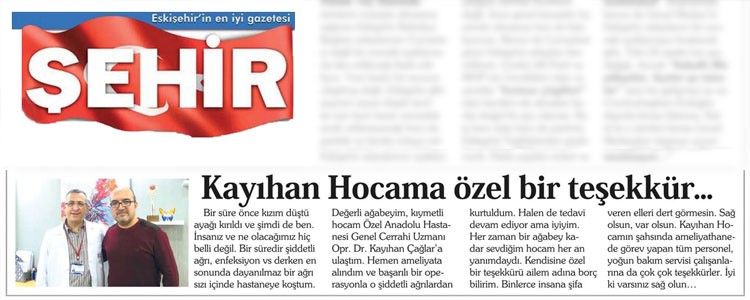
23 11 2018
A Thank-you Letter for General Surgery Specıalıst MD. Kayıhan Caglar
Thank-you letter which published on newspaper for General Surgery Specialist MD. Kayıhan Caglar made us very happy. We wish the continuousness of our doctor's success.
Partıcıpated ın Internatıonal Medıcal Tourısm Islamıc Councıl

12 11 2018
Partıcıpated ın Internatıonal Medıcal Tourısm Islamıc Councıl
In the name of Private Anadolu Hospital , our Hospital Director Ezgi Oktaş participated in International Medical Tourism Islamic Council which organized by Medical Tourism Islamic Council (MEDTIS) in Antalya. About the subject of Health Tourism and health systems in İslamic countries,our country’s public and state hospitals and also our hospital’s International Patient Care Department were introduced on the council.
FOR ZERO WASTE PROJECTS VISITED TO PROVINCIAL DIRECTORATE OF ENVIRONMENT AND URBANISATION

25 10 2018
FOR ZERO WASTE PROJECTS VISITED TO PROVINCIAL DIRECTORATE OF ENVIRONMENT AND URBANISATION
Our Hospital Administrative Director Ezgi Oktaş and Headnurse Gamze Onar Başarangil visit Provincial Director of Environment Hüseyin Çelik for informing about "zerowaste" project which planned by hospital. He is interested in our projects and also we take promise of cooperation on our projects.
STOMACH BOTOX HAS DONE FOR THE FIRST TIME IN ESKİŞEHİR

22 09 2018
STOMACH BOTOX HAS DONE FOR THE FIRST TIME IN ESKİŞEHİR
Private Eskişehir Anadolu Hospital general surgery surgeon doctor Hüseyin Pala has done stomach botox for the first time in Eskişehir for obesity and controlling gaining weight.
Stomach botox isn't a surgery operation .
Endoscopically through into the mouth cutting without suture. It takes on avarage 20 minutes after taking operation patient needs only 1 or 2 hours for observing after observing time patient can go on their daily life.
It has been observed that With Botox enjection patient can loose weight 4 – 20 kilograms in 5-6 months .
Our patient ESEN has problems with losing weight. He took stomach botox operation.
After the operation some changing has been done on peptic gland. Gastric emptying duration lasts longer than before, also digestion has been slow down.
So our patient feels inappetency and also loosing weight. Esen feels so good after taking the operation he offers thanks givings to doctor HÜSEYİN PALA
EREKTILE DYSFUNCTION THE NEWEST TECHNOLOGICAL METHOD IN TREATMENT!

10 06 2018
EREKTILE DYSFUNCTION THE NEWEST TECHNOLOGICAL METHOD IN TREATMENT!
Low-intensity extracorporeal shockwave therapy ,LI-ESWT
Erectile dysfunction (ED) is a health problem that is defined as the inability to provide sufficient erection (stiffness) for sexual intercourse, which severely affects the quality of life of the male partner.It usually affects men over 40 years old,ıt seen at similar rates in Turkey and World.it has been found that the incidence in men between the ages of 40-70 is about 50-60% or more.The incidence and severity of erectile dysfunction (ED) with progressive age increases until %2-%60.
However, it is generally accepted as a normal occurrence with age or for the reason of ashamed.Especially smoking and alcohol consumption, diabetes, high blood pressure, heart disease, high blood fat, obesity, depression and also medicines used in the treatment of these diseases (hypertension, diabetes mellitus etc.) pose a serious risk of hardening problems.
What is shock wave therapy?
Extracorporeal shock wave therapy (LI-ESWT) is a treatment in which very low intensity focused shock waves are given to the penis in short intervals to improve the curing function.It is administered in multiple sessions (6 or 12) and can be repeated if necessary.Shock wave therapy (LI-ESWT) is the latest technological treatment for erectile dysfunction (ED).Drug treatment due to erectile dysfunction (ED) does not actually correct the underlying pathophysiology of ED, which is the disease.There is no effect on maintaining a spontaneous-erection erection.This suggests the need for different treatment strategies in the treatment of ED
As a result, '' low-energy ESWT (Li-ESWT) '' therapy, ie Shock wave therapy, gives spontaneous chance to be a permanent treatment that can also correct spontaneous erection.
How does it effect?
The shock waves generated by LI-ESWT cause small damage to the penis, causing numerous biological changes.As a result, it accelerates activation of the natural healing mechanisms of the body by acting on the stem cells.At the cell level, these stimulants increase blood flow by providing new blood vessel formation in the tissue.The resulting blood vessels will increase blood flow to the penis.This improves the hardening and maintaining capacity.With this new method, the problem of hardening of men, which is a fearful dream, can be treated in a short time.
How does it implementation?
It is a side-effect method that can be applied to any patient who has a problem with hardening.Shock wave therapy is applied to 6 sessions according to the severity of the disease and up to 12 sessions if necessary.It is administered as 2 days, 3 days or every day in a week.
Each session lasts approximately 15 minutes and is administered according to the outpatient conditions.Low intensity ultrasonic sound waves are given to the penis and penis roots at least 5 points during treatment.There is no pain, pain, or disturbance during and after the treatment.There is no pre-treatment preparation, such as a soothing medication, vascular access, serum insertion, etc. before the procedure.There is no restriction in daily life after treatment.
Treatment results?
Patients with erectile dysfunction (ED) are divided into 3 groups as mild, moderate and severe.Shock wave therapy is mild, with a mean success rate of up to 80% after 6 sessions in the middle group of patients.The treatment rate of the patients in the heavy group is 60%. Additional sessions enhance your success.The treatment effect starts 4 weeks after the last session,this is necessary for the formation of new vessels, but in some patients the effect can start sooner.Shock wave therapy applied to the patients in these three groups with erectile dysfunction the cure of erectile dysfunction in the penis has a recovery-to-success ratio and side-effect, which is a new method that can be substituted for drugs.Shock wave therapy (LI-ESWT) can also successfully treat peyronie's disease (curvature in the penis) and chronic prostatitis (prostate inflammation) without treatment, except for erectile dysfunction.
DISCOUNT AGREEMENT BETWEEN ANADOLU HOSPITAL AND ODUNPAZARI MUNICIPALITY

01 06 2018
DISCOUNT AGREEMENT BETWEEN ANADOLU HOSPITAL AND ODUNPAZARI MUNICIPALITY
Private Anatolian Hospital which continues its services by being taken over by new owners, Specialist M.D Levent Bilir and Surgion M.D İ. Cenk Soğukpınar on September 2017 to be continue service. Attention is drawn to the changes in their staff and services.Anadolu Hospital management, which renewed its institutional agreements during the renewal process, Odunpazarı Municipality added a new one to its institutional agreements for its employees.Specialist M.D Levent Bilir and Hospital Administravite Direktor Ezgi Oktaş,Odunpazarı stated that the visit to Mayor Kazım Kurt will provide municipal employees with discounts of up to 30% in some services.After a mutual agreement signed by Mayor Kazım Kurt and Hospital Partners Levent Bilir, Mayor Kurt stated that they are pleased with this privilege to be provided to their employees.He thanked to Specialist M.D Levent Bilir.
OUR HOSPITAL VISIT TO ESKISEHIR 112 PROVINCES OF AMBULANCE SERVICE

15 05 2018
OUR HOSPITAL VISIT TO ESKISEHIR 112 PROVINCES OF AMBULANCE SERVICE
We have visited to Eskişehir 112 Provincial Ambulance Service Chief of the new doctor Veli Görkem PALA on 15.05.2018.We wished him success to be a Private Anatolia Hospital on his new duty.
our hospıtal has been ın belgıum to meet turkısh people who are lıvıng ın belgıum

12 05 2018
our hospıtal has been ın belgıum to meet turkısh people who are lıvıng ın belgıum
Private Eskişehir Anatolian Hospital will be in the service of expatriates living in Europe besides Eskişehir with new administration and renewed buildings and services.Ezgi Oktas, Business Manager of Private Eskişehir Anatolian Hospital, who came to Belgium, met with expatriates in Brussels.Ezgi Oktas, who visited the Turkish tradesmen and associations in the Turkish neighborhood Schaarbeek town, introduced the renewed Private Eskişehir Anatolian Hospital and listened to the health problems of the expatriates and invited them to their hospitals.Private Eskişehir Anatolian Hospital Operation Manager Ezgi Oktas has announced that they have provided services in Eskişehir with their new management and specialist and experienced doctors.
More on the news;http://gazeteturk.be/haber/oezel-eskisehir-anadolu-hastanesi-belcikada-gurbetcilerle-bulustu-6651





























































